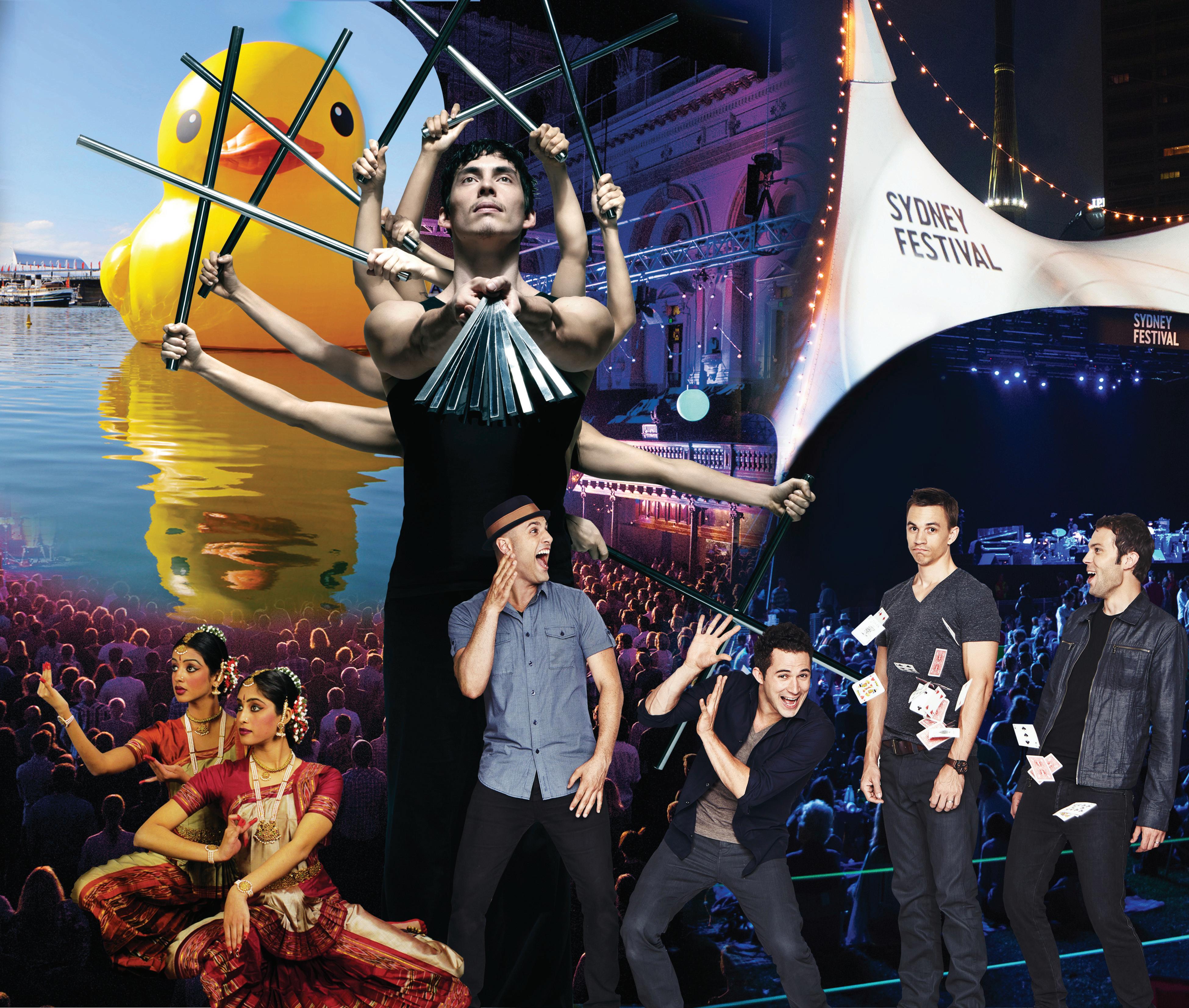


FREE Vol. 21 No.3 (2) • DECEMBER (2) 2013 • www.indianlink.com.au FORTNIGHTLY SYDNEY Sydney • Melbourne • AdelAide • briSbAne • Perth • CAnberrA SYDNEY EDitioN Level 24/44 Market St, Sydney 2000 • GPO Box 108, Sydney 2001 • Ph: 18000 15 8 47 • email: info@indianlink.com.au Indian Link Star Partner IndIan LInk’s top 10 pIcks
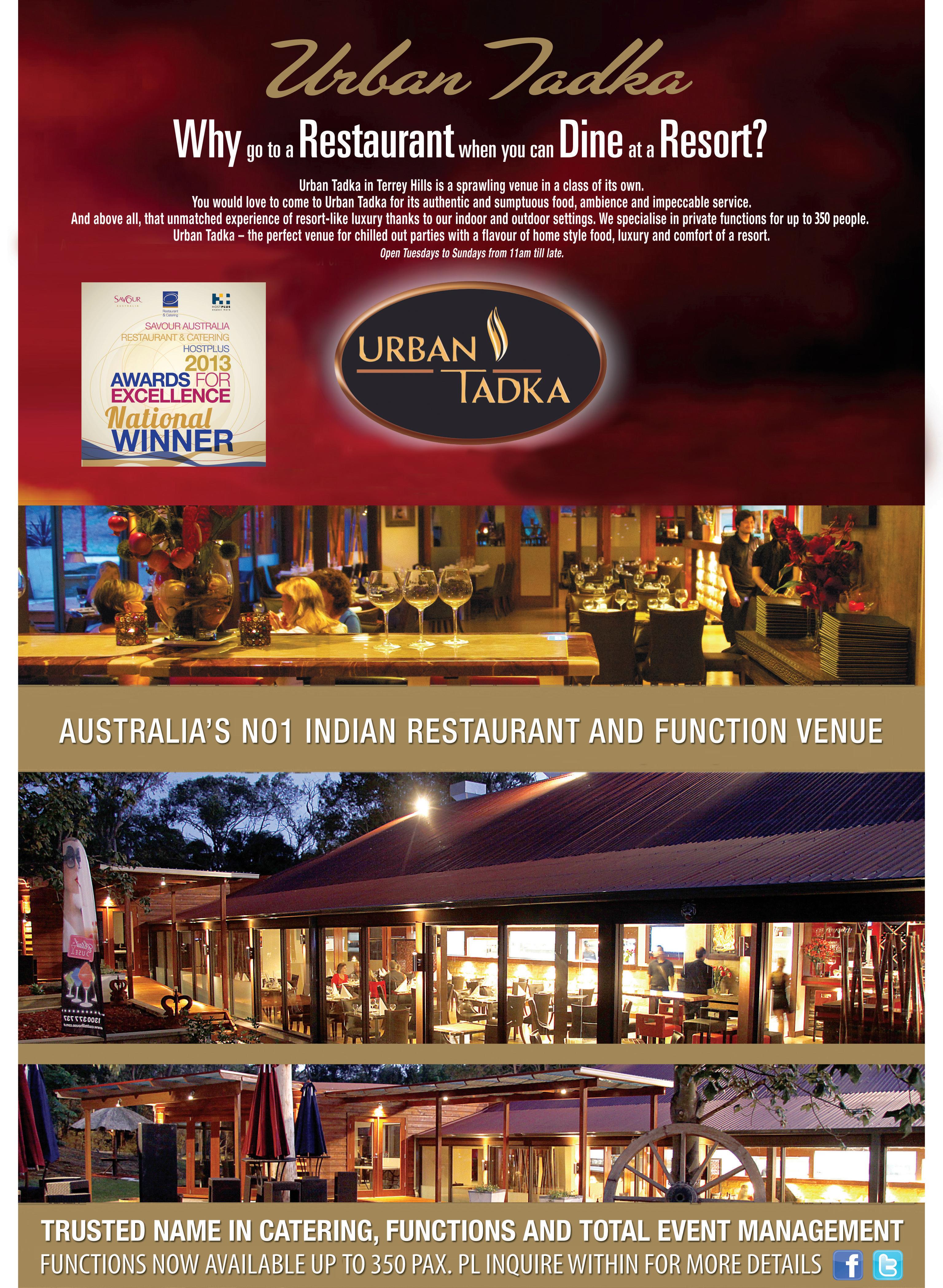
2 DECEMBER (2) 2013 www.indianlink.com.au Hosts: Dimpy Singh 0415 178 620 Mandeep Rana 0413 993 448 321 Mona Vale Road, Terrey Hills, NSW 2084 Ph: 02 9986 1040 www.urbantadka.com.au

december (2) 2013 3 NATIONAL edITION
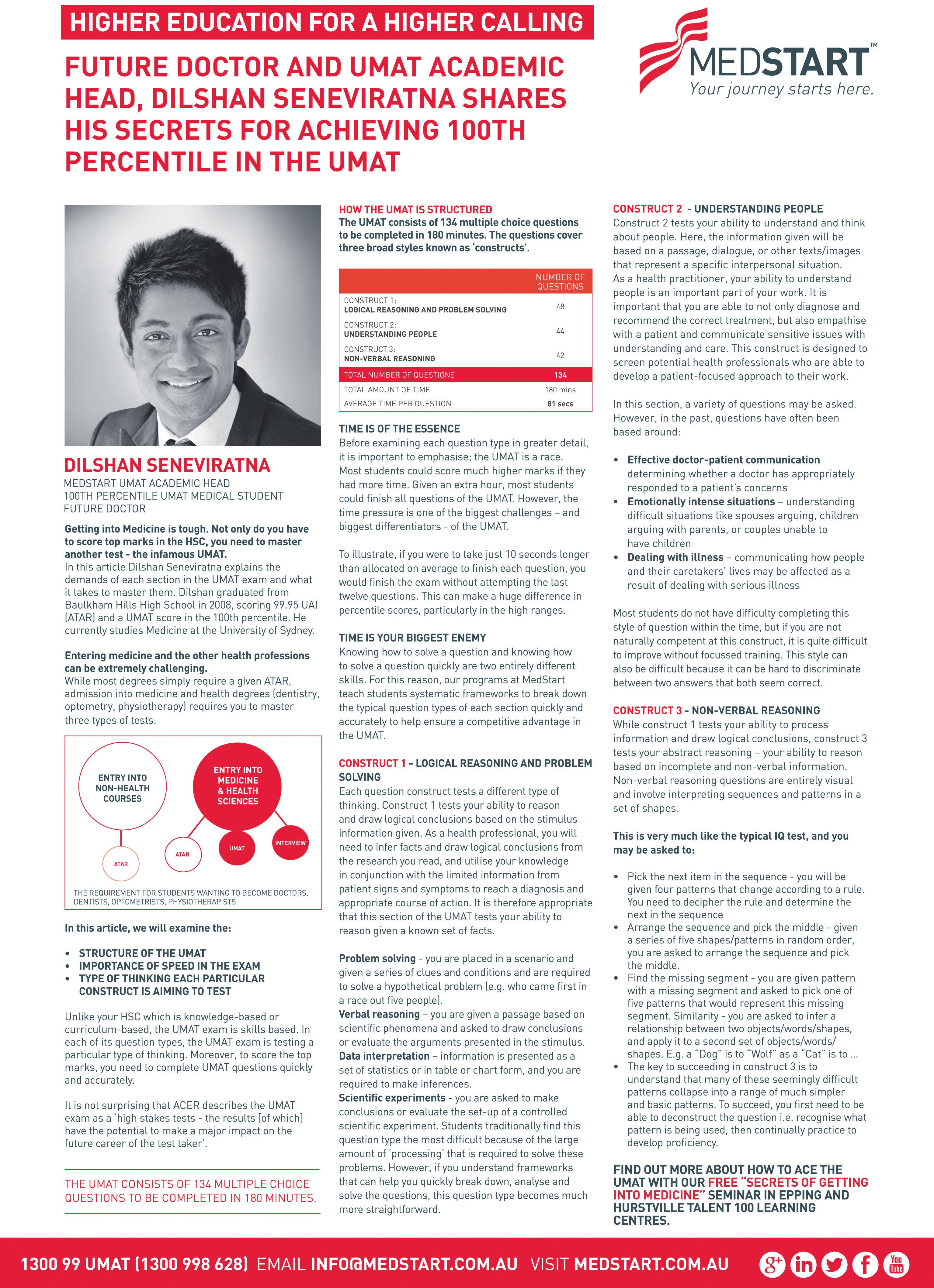
4 december (2) 2013 www.indianlink.com.au

december (2) 2013 5 NATIONAL edITION

6 december (2) 2013 www.indianlink.com.au
INDIAN LINK
PUBLISHER

Pawan Luthra
EDITOR
Rajni Anand Luthra
ASSISTANT EDITOR
Lena Peacock
Sheryl Dixit
MELBOURNE
Preeti Jabbal
CONTRIBUTORS
Sandip Hor, Jyoti Shankar, Deepa Gopinath, Deeksha Chopra, Emie Roy, Astha Singh, Mohan Dhall, Kritika Rao, Noel G De Souza, Priyadarshini Chidambaranathan, Tasneen Zavery, Petra O’Neill, Kalyani Wakhare, Eleanor D’Souza, Vishma Mistry
ADVERTISING MANAGER
Vivek Trivedi 02 9262 1766
ADVERTISING ASSISTANT
Nitika Sondhi 02 9279 2004
DESIGN Danielle Cairis
Proud member of:
Indian Link is a fortnightly newspaper published in English. No material, including advertisements designed by Indian Link, may be reproduced in part or in whole without the written consent of the editor. Opinions carried in Indian Link are those of the writers and not necessarily endorsed by Indian Link. All correspondence should be addressed to Indian Link
Level 24/44 Market St, Sydney 2000 or GPO Box 108, Sydney 2001 Ph: 02 9279-2004 Fax: 02 9279-2005
Email: info@indianlink.com.au
www.indianlink.com.au
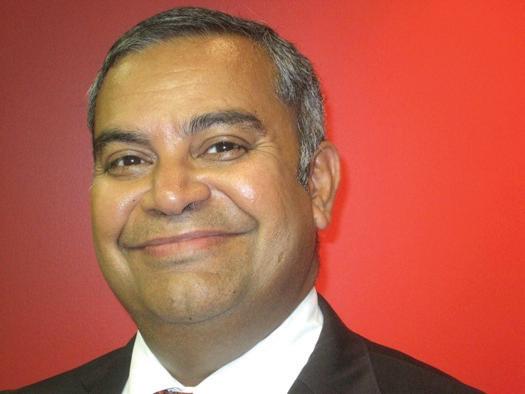
The year ahead
stage. One predicts that they will perform well, but will be more of a threat to the Congress than to the BJP.
2014 is shaping to be a year that, while some changes can be predicted, we can also expect to be more like 2013. But the beauty of life is that nothing is predictable, and a few surprises will ensure the truth in the wellknown saying that ‘we live in interesting times,’ is likely to be uttered many a time in 2014!
India will be going to elections in 2014 and it seems that the Congress, increasingly losing favour with the general public, will lose government to the BJP-led NDA. Rising costs of basic goods, high inflation, corruption and lack of leadership seem to be the reasons why the Indian public is looking for a change. Riding on his success in his native Gujarat, Narendra Modi of the BJP seems destined to be the next Prime Minister. He will have his hands full to get the country back on track for a sustainable real growth target and opening up bottlenecks in the economy. Meanwhile, the recent success of the Aam Aadmi Party (AAP) in the Delhi elections has fired up the imagination of the masses and catapulted this party on the national
Social issues reform will still be a work in progress. A year since the brutal rape in Delhi, some progress has been made in empowering women to speak out as evidenced by the allegations against Tehelka editor Tarun Tejpal and Justice Ganguly, but it will take time for the effects to filter down.
The US will need to further determine its position as leader of the free world. After suffering a humiliating backdown against the Assad regime in Syria, its support for Iran is testing its friendship with Israel. If the US has read the play correctly and Iran does want to build bridges, then it will be a coup for the US. But if Iran turns against the spirit of their agreement, the US will further lose in status.
China will try to assert itself as an alternative economic power, but as the US economy recovers, it may be a bridge too far to build for the People’s Republic. Expect more good news out of the US economy.
Australia could have a mixed year. Politically it will not be smooth sailing for the Abbott government till mid next year, when the Senate changes. While the Coalition government is keen to repeal a few taxes such as the mining and the carbon tax, this will likely not happen
till they have control and more allies in the Senate after July 2014. Around this time there will be more discussions about easing work restrictions to free up some shackles which Labor put in place during their term in government. Increasingly over the year, there will be options to free up the inflow of new migrants to give the economy more momentum.
The local Indian community leadership will be concentrated in smaller circles. Current established organisations such as the UIA, CIA and IAA-NSW will need to be more transparent and show leadership on issues which really serve the needs of the community. Social issues such as seniors’ needs, aged care, domestic violence, should be areas of focus. The strength to tackle these will come from the community itself, and true leaders will be able to harness this strength for the greater good. With expected changes to government policies, there should be a revival of students from India coming here for education, as compared to 457 migrants over the last few years. With a lower dollar and open options, migrant trends will start shifting.
But eventually, it is likely that the truth will be stranger than these predictions, for while predictions have to stick to some semblance of reality, truth does not.
Have a wonderful festive season and wishing you and your loved ones a happy and healthy 2014.
DECEMBER (2) 2013 7 NATIONAL EDITION
EDITORIAL
PAWAN LUTHRA





8 DECEMBER (2) 2013 www.indianlink.com.au sPecial features indian link L i N ki N g i N di A W i TH AU s TRAL i A SPECIAL REPORT Eight participants, 14 medals: An impressive tally at the Special Olympics SPORT Amandeep Singh wins Mr Australia and aims for Mr World VOLUNTEERING Put your hand up! Volunteering and travelling to make a difference THE YEAR IN REVIEW A look at the major events that defined the year that was 2013 contents 12 TELEVISION Manju Jehu’s samosa success on Recipes to Riches 47 38 30 47 Indian Link 19 30 38





december (2) 2013 9 NATIONAL edITION IndIan LInk CompetItIons Get notifications and enter our latest competitions by: /IndianLinkAustralia Sign up to receive our e-news www.indianlink.com.au Follow us /Indian_Link There’s stacks of great prizes including Sydney Festival tickets, Bollywood movies and more!



10 DECEMBER (2) 2013 www.indianlink.com.au
diwali celebrated at Parliament House

Parliamentarians and the Indian diaspora enjoy a meaningful celebration
BY AsTHA siNgH

On December 2, Diwali was celebrated by the Federal Parliament in Canberra, cohosted by the Hindu Council of Australia (HCA) and was very well attended by a large number of parliamentarians, community and religious groups, media organisations and diplomatic heads. Over 150 guests attended the celebration which has become a platform for the Indian diaspora to mark their contribution to Australian multicultural society.
Bill Shorten, Opposition Leader, spoke at the commencement of the event, regarding the increased involvement of the Indian community in Australia since the last decade. “I understand that Diwali is a festival celebrated to recall happiness, acknowledge fresh accounts of business and prosperity, and relive the bond between brother and sister,” he stated, also commenting on the remarkable inclusiveness, closeness and kindness of the Indian community.
Bala Subramaniam then invited members of different faiths to light the ceremonial lamp (diya). Distinguished guests such as the Hon Concetta Fierravanti-Wells; Mr Surinder Datta, Deputy High Commissioner of India; Professor Nihal Agar, Chairman HCA; His Excellency Mr Rudra Kumar, Ambassador of Nepal; Mrs Cheryl Brown-Irava; members of the HCA and parliamentary members were welcomed, among others. Ms Manasa Chintakindi performed the welcome song, Prathama suman sri ganesha, followed by anointing guests with a teeka, as per tradition.

Speaking on the occasion, Prof Agar thanked all for the great success of this year’s Diwali Fair in Sydney. “By holding Diwali celebrations in Parliament House, we celebrate cultural diversity and multicultural inclusion of Australian society,” he stated.
Ms Fierravanti-Wells, looking
radiant in her lovely bright green saree, acknowledged the assistance of Senator Zed Seselja for supporting this initiative, and congratulated Prof Agar and the HCA for its ongoing commitment and dedication, and for presenting a united voice on behalf of the Australian Hindu community. “We are blessed to live in a country where people have the freedom to worship, express and practise their faith without intimidation or interference, as long as those practices comply with Australian law. In Australia we are committed to creating a society where diverse cultures, religions and races peacefully co-exist and contribute to universal peace and harmony,” she stated. “In tonight’s celebration, we extend our hand of friendship to all Australians seeking to promote and increase our understanding of different faiths. We need to continue to promote community harmony and understanding between different faiths. Living harmoniously and respecting one another are the cornerstones of a successful multicultural society,” she added.
Ms Michelle Rowland, MP Shadow Minister for Citizenship and Multiculturalism, and Shadow Assistant Minister for Communications, emphasised the significance of Diwali and her respect for Hindus and the HCA, that is very inclusive and accepting of other cultures.
Mr Datta then spoke about the meaning of Deepawali and the triumph of good over evil through the symbolism of light, while elaborating on the history and significance of the festivals for different faiths and occupations.
Next, Kanti Jinna, Vice Chairman HCA mentioned the record presence of 25 MPs and 9 senators at the Diwali celebrations, followed by a presentation on Diwali by Sanjeev Bhakri, which covered its elaborate history, meaning and different facets of the festival.
Mr Seselja, Liberal Senator for ACT delivered the Prime Minister’s message, and Lisa Singh, Labor Senator from Tasmania enlightened the guests about the spiritual and fun side of Diwali. The first Hindu and
Indian Senator in Parliament, Ms Singh acknowledged the contribution of the 400,000 people of Indian origin here. She spoke about Diwali beyond Hinduism as a broader faith that exhorts good citizenship and humanitarianism. Senator Singh also hopes that Diwali will one day be a public holiday in Australia. “To me, (Diwali) reaffirms the things in life that matter most, that life’s greatest joys are the simple pleasures that come from spending time with people we love. (Diwali) is also an opportunity to celebrate the strong relationship between Australia and India,” stated Ms Singh in a message to Indian Link
The Hon Philip Ruddock, MP Member for Berowra, NSW then spoke about Australia’s political history since PM John Howard, stressing that the HCA’s origin in the 90s has helped others to learn and understand Diwali. “I invite others to participate and make Australia an even greater nation. We are not perfect, but better than everybody else,” said Mr Ruddock. He also mentioned the great multicultural society of India that itself signifies inclusion of different faiths, different religions and cultures, and goes very well with the Australian way of multiculturalism.
The event concluded with a vote of thanks by Prakash
Mehta, Director, HCA and an acknowledgment of the assistance from Senators Ms FierravantiWells and Mr Seselja, and His Excellency Mr Biren Nanda, High Commissioner of India and their staff in presenting the program. Delicious traditional sweets and refreshments brought the taste of festive food to the attendees.
The event was vibrant and remarkable, with inspiring speeches and distinguished guests. Diwali has been celebrated in Parliament since 2004, and this year’s event marked yet another positive comment on Australian multiculturalism, indicating that our seat of government is available for all to share and enjoy.
DECEMBER (2) 2013 11 NATIONAL EDITION
DIWALI
indian Link’s
band of magicians 10-19 Jan
RIveRSIde THeATRe Sydneyfestival.org.au/magicians
If magic is your thing then this is one not to be missed… Illusion, deception and magic!

festivaL viLLage 8-26 Jan
Sydneyfestival.org.au/village | FRee | CLOSed MONdAYS
This is one for the families. The middle of Hyde Park will be transformed with food stalls, tunes, free events. And Sacrilege, a life size bouncy inflatable version of Stonehenge will be there too. And the best part?
It’s not just for the kids!
am i 9-11 Jan
dRAMA THeATRe, SYdNeY OPeRA HOuSe Sydneyfestival.org.au/ami dance and music meet to explore then concept of “I”. Featuring Shantala Shivalingappa.
cHi udaka 16-18 Jan
YORk THeATRe, SeYMOuR CeNTRe Sydneyfestival.org.au/chi
A fusion of Indian dance and Japanese drumming.
tHe caLLing 11-12, 18-19 Jan
I NFORMATION AN d Cu LT u RAL e xCHANG e, w e ST e RN S Yd N e Y Sydneyfestival.org.au/calling
2. 7. 4. 9.
This involves jumping onto a bus and going on what they’re calling an inter-faith tour exploring religious architecture, sacred music and worship.
dido & aeneas 16-17, 19-21 Jan
SYdNeY LYRIC, THe STAR sydneyfestival.org.au/dido underwater. Opera. Need we say more?
tHe serpent’s tabLe 24-27 Jan
C ARRIAGewORkS BAY 20
Sydneyfestival.org.au/table
This is for all of the foodies out there. Combining storytelling, installation, and of course, great food, five Asian-Australians share their recipes and more.
parra opening party 10 Jan
PARRAMATTA CITY, STRee TS ANd PARkS | FRee
It’ll be a family friendly summer night full of food, street theatre, a street parade, Boxwars, Californian jazz, blues and more. And make sure you see the Rubber duck, because it’s back and heading down Parramatta River this time.
Limbo 9-26 Jan
THe SPIeGeLTeNT, HYde PARk Sydneyfestival.org.au/limbo
This is a naughty one, so leave the kids at home. It’s like a circus meets cabaret that’s on steroids. It’s jam-packed full of dirty, dangerous, jaw-dropping contortion, acrobatics, stunts and illusions.
paradiso at town HaLL 16-25 Jan
Sydneyfestival.org.au/paradiso
i ndian Link is very excited to be a s tar partner of s ydney f estiva L 2014. Here are our picks of w H at not to miss! 1. 6. 3. 8. 5. 10.

And now one for the party animals! Sydney Town Hall will be transformed into a live music venue, named after the legendary Amsterdam rock venue.

12 DECEMBER (2) 2013 www.indianlink.com.au cOv ER s TORy
* *
syd fest guide
* * band of magicians
dynamic. Contemporary. Band of Magicians are what some are calling the first boy-band of the magic world, or as they describe themselves, ‘The World’s First Magic Supergroup’.
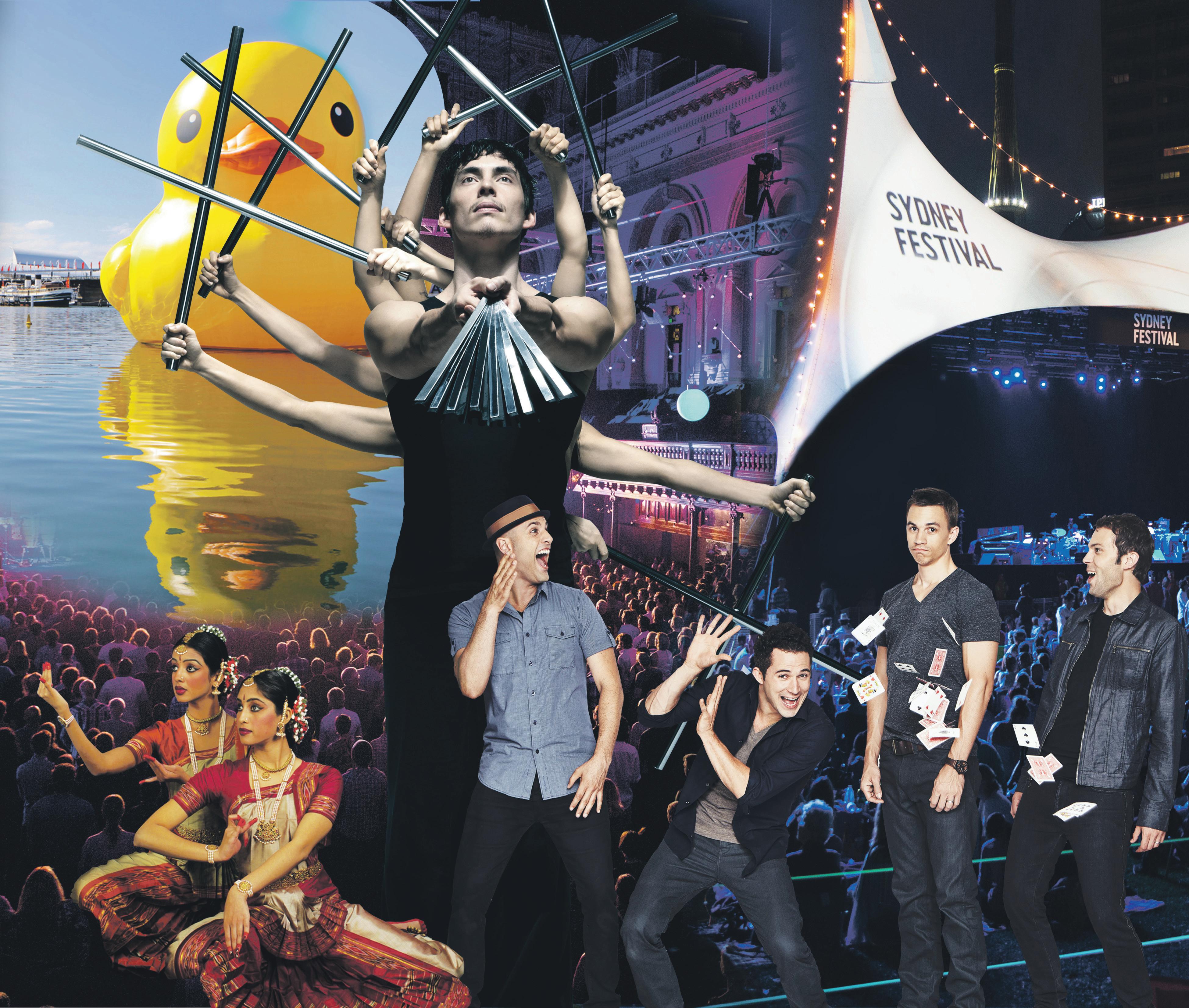
Americans Justin Willman, Nate Staniforth, Justin Flom and Australian James Galea have already impressed the eyes of America, and now they’re heading to Sydney for summer. Bringing a new meaning to the usual oneup-manship that occurs over one’s cricket skills (or ability to recount the latest match in the most detail possible), these boys will show off their magic tricks, illusions and deceptions together for the Sydney Festival.
“There’s no such thing as magic,” it’s all just illusion, says James Galea, who wants his brand of illusion to break all of the clichés of pulling rabbits out of hats. When even Ellen Degeneres tells you to “Wait ‘til you see James Galea, he’s not like other magicians. He’s not creepy,” you know that what’s in store is something just a little bit different and more exciting than creepy men hiding cards up their sleeves and birds in their hats.
Galea began performing magic when he was 14, which he says




is a lot later than most kids who get their first magic kit. He had someone take him under their wing to teach him all about the world of magic, which he later learned was a conman, of all people. So Galea had a slightly different start from the usual innocent card trick. Galea also tried out comedy and acting before he turned to magic, which might explain his charismatic stage presence. But when he first started out, he had to look to American magicians, as there wasn’t much going on in the Australian scene at the time.
Responding to the question of what he does for a living, his answer of ‘magician’ was always met with ‘what kind of instrument do you play?’ Now he can say he’s both a magician, and in a band, with a smirk.
Nowadays, Galea is known as Australia’s number one magician. “A year ago I sent an email to three of the best magicians in the world whose work and style I’d respected and admired,” he
of its parts. I likened it to a group of jazz musicians who all played different instruments coming together to play the same song, and how much more amazing that is, than a solo. That’s how Band Of Magicians was born,” he adds. Created just a year ago, the show will highlight their individual acts, as well as new ones they’ve created together.
“Magic is different from music in that it’s difficult to collaborate,” says Justin Flom of their group.

to experience it!”
“We each approach the craft in a different way, we each have our own ideals concerning what makes a good illusion, and the power that comes from joining these four visions together into one show has allowed us to create something that none of us would have ever come up with alone,” explains Nate Staniforth.
“Magicians almost never collaborate,” continues fellow American from the group, Justin
of the minds, and it has never been done before,” says Willman. And because he thrives on audience participation, he can’t wait to meet the “people of Sydney, one at a time, on stage, and frying their brains”. So watch out!
“I’ve been living in Los Angeles for the last five years, so I’m super-excited to be bringing Band Of Magicians home for its World Premiere at the best time of year to be in the city, and show it off to the guys,” finishes Galea. You just can’t beat summer and Sydney!
Lena Peacock

DECEMBER (2) 2013 13 NATIONAL EDITION
a dasH of iLLusion, a bucket-fuLL of deception and a pincH of magic creates a truLy contemporary styLe of one-up-mansHip
indian Link’s

Acontemporary dance and music collaboration between choreographer and director Shaun Parker and composer Nick Wales, Am I will be performed as a world premiere for Sydney Festival at the Sydney Opera House. Exploring the quintessential meaning of “I”, Am I asks the audience “Am I my tribe? Am I my genetic blueprint? Am I a random cosmological sequence?”
“Set sometime in the near future, [Am I explores] seven individuals [who] seek to re-establish a new civilisation, observing the frailties and mishaps of those that have gone before them,” reads the Sydney Festival website. “Religion meets science in this new world
order as society fluctuates between conflict and harmony”.
Through Am I, Parker “Wants to push the choreographic language to the next level in the sense that it’s visceral, it’s physical, it’s highly articulate, and it’s complex in a way that we are as humans,” he told Indian Link. This self-devised piece integrates live music, voice and dance with ancient fan and stick weaponry as it explores culture and anthropology. “It’s a very contemporary dance language, it’s now,” said Parker, and it uses “a lot of locking and popping movement”.
Due to the improvised nature of the piece, each of the 14 extraordinary dancers, musicians and singers were able to add their
* a m i *
own touch to Am I, including international guest artist Shantala Shivalingappa, a Kuchipudi dancer. Born in India, and brought up in France, Shivalingappa’s gestural work can be seen incorporated in Am I, as well as a piece which she sings in Sanskrit. Indian dance, as well as movement inspired by other cultures, can be seen in the piece, as it explores the idea of ‘international tribes’.
Shivalingappa, Parker and dramaturge Veronica Neave visited India to research dance in January 2013.


“One of the challenges of working with a group of not just dancers, but also musicians and singers was in the detail,” Parker explained to Indian Link. While allowing improvisation and free form, the challenge of working like this is in remembering what has just been created. By “recording the work with video” and endlessly going back over material, the original magic of the improvisation is kept, as well as the successful moments of the piece. Recording the work stops it from just being one “endless jam” session, explained Parker.
Because Wales and Parker have produced five collaborative performances together in the past (their first being in 2007), the
dance and music works seamlessly. The live soundscape creates an immediate response in the dancers’ bodies. Wales explains that the music is a hybrid fusion of devotional cult-like singing and ethnic woodwind, percussion and string instrumentations.
As Am I developed, Parker contacted Dr Helen Johnston, Senior Lecturer, School of Physics at the University of Sydney, to gain insights into DNA, physics and movement. To explore the ideology, Parker used Johnston’s expertise to look at the individual as a result of cultural conditioning that defines us and who we are, and the idea that the genetic information of ‘tribes’ is passed through behaviour and the subconsciousness of humans.
Am I can then become a “gateway to larger learning,” said Dr Johnston.
Because the body expresses a thousand words, it can crystalise notions of physics through its movement. But it wasn’t just the world of science that Parker wished to explore, as he is just as interested in the notion of spirituality.
Am I is 75 minutes in length (with no interval) and is “highly physical, bombastic, delicate, articulate, with a huge amount of detail in a small amount of time,” said Parker. It expresses information going through cells, just like the internet.
Of the stick weaponry scenes, Parker explains that they came
about because of cello player Julian Wong’s background in martial arts, who, after some improvisation with Parker, became a dancer in the piece. The wooden sticks were however, changed into metal sticks because of the connotations that metal has with technology. “As society progresses, metal is developed, which changes society,” said Parker. “Here the metal sticks symbolise the turning point, scientifically and spiritually. They become an absolute symbol of man’s learning, a symbol of many things,” he added.

Am I embodies the fusion of science and artistic form which compels Parker, from the creation of the universe, to the formation of consciousness, spirituality and society. “The beginning of the show starts with a pulse of life, the Big Bang Theory, the creation and expansion of the universe catapulting through time,” said Parker.
“Using bodies to express” energy and motion, Am I features Josh Mu, Sophia Ndaba, Jessie Oshodi, Marnie Palomares, Melanie Palomares, Shantala Shivalingappa, Julian Wong, Tunji Beier, Alyx Dennison, Jess Green, Jason Noble, Jessica O’Donoghue and Bree Van Reyk.
Parker wants the audience to walk out of the performance wondering what it means to be human, and Wales wants them wondering if the music was from “the future or the past?” Am I is after all, a perpetual question, as well as a tantalising statement.
Lena Peacock
14 DECEMBER (2) 2013 www.indianlink.com.au
cOv ER s TORy
dance and music coLLide in visceraL and pHysicaL expLoration of wHat it means to be a part of tHe gLobaL tribe tHat Locks and pops
* c H i udaka
Come January and a dynamic fusion of music and dance, an innovative crosscultural partnership, will have its world premiere at the Seymour Centre in Sydney. Japanese taiko drumming and melodious shakuhachi flute sounds will merge with intricate classical Indian dance movements of Bharatanatyam and Kuchipudi to create Chi Udaka. The meeting of the chi (earth in Japanese), symbolised by the deep earthiness of taiko drumming, and the
own art, and their willingness to blend and collaborate. This show is part of the 2014 Sydney Festival, but the project took its roots over three years ago. TaikOz is responsible for introducing the art of wadaiko (Japanese drumming) to Australia and has appeared on stages worldwide. Lingalayam as a dance academy, was started in 1987 and Lingalayam, the dance company, began in 1997 to provide graduates from the academy an opportunity to become more proficient in their skills and work on such artistic ventures
Chi Udaka
as

Nivedha and Ritika, about the upcoming show. Both, who have been learning classical dance since they were around seven to eight years of age, said that dance was such an integral part of their lives now, that it was second nature to them. Every Monday they head for Valli Aunty’s place, as Anandvalli is affectionately known to all her students, to dance and rehearse.
The show means more practice sessions, with frequency increasing to daily soon. The planning and choreography for the show began way back in 2011.
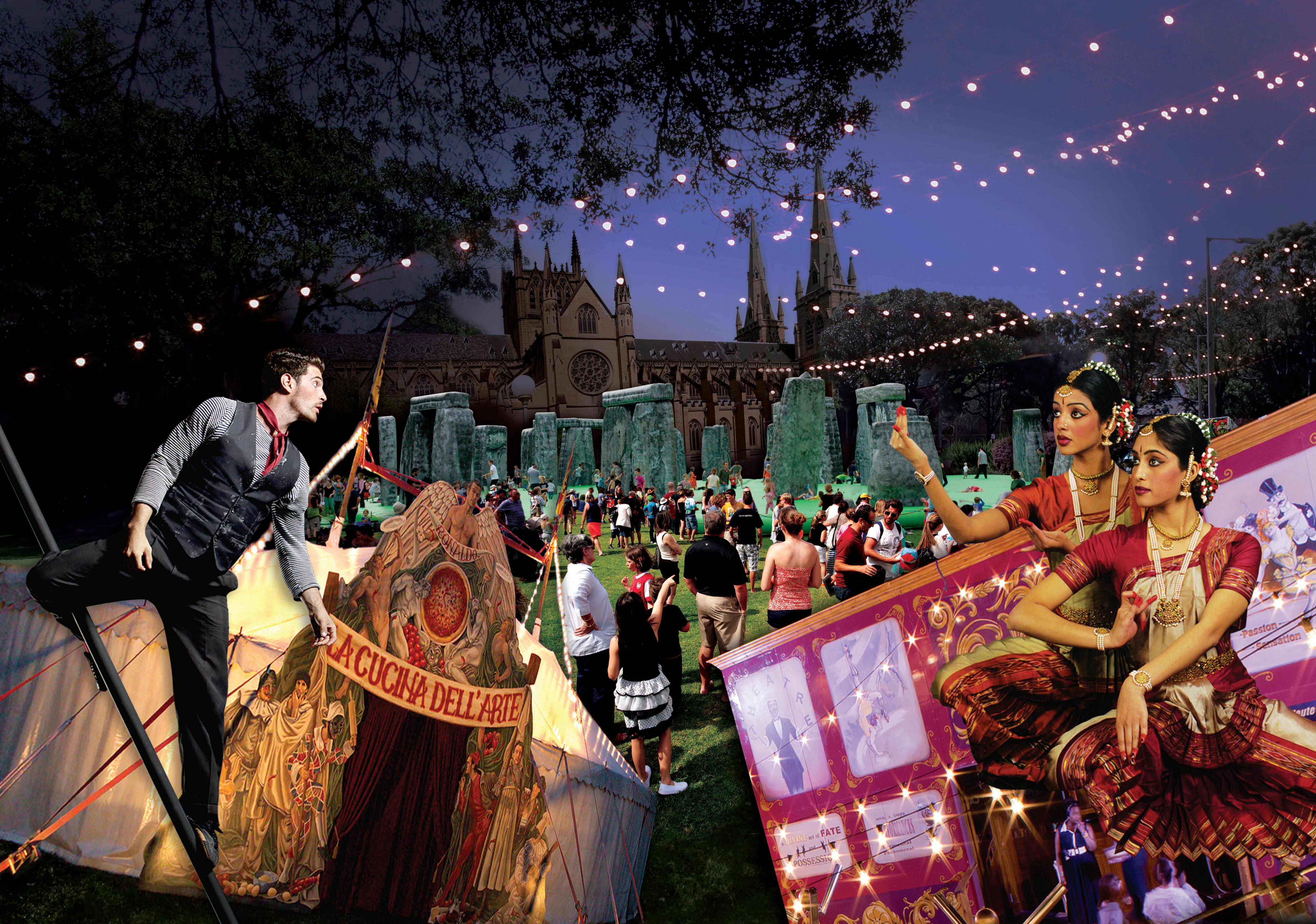
finale piece. This show is indeed a culmination of these collaborative workshops”. The first stage of creative development in 2011 was funded by the Australia Council for the Arts and the workshop at stage two in 2012 was funded by Arts NSW, which gave them an opportunity to complete the work. Since then they have been honing and practising on the work.
The first time they heard Taikoz drummers, they were terrified!
“The drums are loud, very loud. We had heard snippets on CD, but we don’t get the impact until we are right there. We tried dancing to the sounds of the drums before the first workshop and we thought we were choreographing to a reasonable speed. That was until the drummers started playing live, and we found the speed to be ten times faster! It was almost like we were dancing in fast forward!”
Ritika reminisces.
Separate pieces blend together seamlessly. The six musicians are not stationery. They move around and dance too.
Anandvalli in an open letter to her patrons on her website says, “For me personally it has been a very gratifying journey collaborating with Ian Cleworth, and in turn TaikOz”. She has high praise for Ian’s musical skills and brilliant composition, with a rare ability for creating a score perfectly suited to the artistic work at hand.
“The mostly original musical score written by Ian and Riley for Chi Udaka has inspired a choreographic vocabulary like you have never seen Lingalayam deliver!” she states.

tradition and history. It is no mean achievement to create this fusion while maintaining these traditions but Anandvalli, Artistic Director of the Lingalayam Dance Academy, and Ian Cleworth, Artistic Director of TaikOz, seemed to have pulled it off with their mastery over their

While Anandvalli is busy in India this month trying to organise last minute costume and accessory fixes, her wards, six senior dancers from the academy, are busy practising in preparation for the shows, to be performing January 16-18, 2014. And it isn’t easy for these young women with working lives, children and one even living in Canberra, to fit dance into their busy schedules. Indian Link spoke to two of the performers,
“We had two workshops of two weeks each with Taikoz in two years,” Ritika says. “Ian and Valli aunty came up with a framework and a structure, but not much was choreographed until we met. The workshops gave us an opportunity to collaborate. We choreographed along with them. As we heard the music and saw how they played and they saw how we danced, the choreography fell into place. The second workshop gave us an opportunity to add another
“We can feel the music pounding in our chest when dancing. It amps one up and excites one when we dance with them,” adds Nivedha.
In the show of an hour, there are dynamic fast-paced earthy dances accompanied to the sounds of taiko drums and soft dances that depict the flowing sensuousness of water, accompanied the sounds of the Riley Lee’s shakuhachi, John Napier’s cello, and an overlay of classical Indian overtones and vocals by Aruna Parthiban.
From the clipping of the show I have seen online and from what I heard described by the dancers, it seems like it would be hard to say if this synthesis is music in dance, or dance in music. The movements and sounds all integrate and change forms constantly, and together create an experience that will be worth listening to, viewing and into which you could submerge. As the Taikoz drummers say, “To beat with every muscle, bone and sinew in our body with an open and joyous spirit,” which is their motto, so too the dancers from Lingalayam aim to match their exuberance with their own footwork and beautiful body movements.
Jyoti shankar


DECEMBER (2) 2013 15 NATIONAL EDITION
*
a compeLLing fusion of indo-Japanese cuLture Has created an intrinsic dance artform tHat is traditionaL, yet contemporary
indian Link’s
sydney festiva L guide
*t H e c a LL ing
When one drives or walks
past places of worship, one’s natural curiosity is sparked. Whether an awe inspiring mosque with its hauntingly beautiful call for prayer, a Hindu temple with its intricate architecture, or the simplicity of a contemporary suburban church, one can’t help but wonder how those within the building express their devotion. During The Calling, a tour organised by Information and Cultural Exchange (ICE), the doors of certain places of worship in suburban Sydney will be thrown open to the tour’s attendants in an attempt to share the inner workings of these important buildings. A part of Sydney Festival, the tour will be a multimedia experience for Sydneysiders, incorporating music and performing arts into what is sure to be an unforgettable day out.


The tour begins at the somewhat unearthly hour of 5:30am. Understandably so, as this is when the morning Adhan (call of prayer) is projected from a minaret of the Gallipoli Mosque in Auburn. Spoken in a way that it becomes a haunting melody, the call is similar to that which is issued from many minarets of many mosques around
the world. It is a sound which is uniquely Islamic and undeniably captivating. The Adhan signals the beginning of a new day and welcomes devotees of Islam to commence their first prayer. An Islamic leader will address the tour attendees with a brief discussion about the mosque, its architecture and the religion it represents. This is a feature that is also planned in some of the other religious venues of the tour.
An important feature of The Calling is performances by artists such as Aruna Gandhi, who will perform a Bharathanatyam piece at the Sydney Murugan Temple. An apt addition, as Bharathanatyam is a classical dance form that originated in the Hindu temples of south India. Aruna will be performing a very traditional and devotional piece called a Kavuthuvam with live music accompaniment. The experience of sitting on the floor of a Hindu temple listening to live carnatic music and watching a temple dancer while breathing in the mingled scents of incense, camphor and fresh flowers is a truly unique one. This will be an incredible opportunity for those present to immerse themselves, albeit for a short time, into some of the most lovely aspects of Hinduism.

As a soundtrack to the tour, attendees will be drawn into the sounds of prayer by transitional music compositions that were created especially for this project. Jonathan Wilson, curator of the project, finds the sounds that align with religious rituals to be particularly fascinating.
Jonathan explains that many of Sydney’s residents are equally fascinated by the beautiful temple they drive past every day to work, or the quaint little church around the corner, but may feel hesitant to step into these spaces on their own. An inadequate understanding of a different culture as well as a

fear of offending another religious group, may hold many back from visiting religious buildings. The project evolved as a way to offer interested people an entry point into the diverse cultures that populate Sydney’s western suburbs. The minibus tour has been designed to be a snapshot of these religious spaces and the practices that take place there. It is a window into how various cultures converse with God, and an opportunity for attendees to come together to respectfully understand different religions. Attendees will be required to follow the conventions of each
venue, whether that involves removing shoes, covering their heads or speaking quietly. They will be rewarded for their efforts by a unique cultural experience that will deepen their understanding of some very prominent cultures that make up our city. The sumptuous traditional Lebanese breakfast that is included in the tour will no doubt be a welcome bonus! The ‘sold out’ status of The Calling indicates that Jonathan’s instincts were correct; the people of Sydney are ready to embrace this project and to explore the diversity of the religions that surround us.
deepa gopinath

16 DECEMBER (2) 2013 www.indianlink.com.au
cOv ER s TORy *
a unique tour of western s ydney’s diverse p L aces of wors H ip promises to be an en L ig H tening experience
457visasfor FastFoodbusiness (Pizzas,Burgers, SandwichesSubmarines,etc.)
Free Visa Advice & Assessment* for Students & their Employers
Course Admissions (Australia wide), Student Visas, Work/ Sponsorship Visas (457s, RSMS, ENS), Partner Visa, Family Visa, Tribunal Appeals & Waivers, General Skilled Migration. Our clients are our best spokespeople:
• ...is highly reliable and efficient in his work, we always consult him for our (457) applications...wish him the best. - Michele, Brisbane, QLD
• ...is expert in 457 visas and I am so grateful to him to successfully complete our family application. Thank you - Gurvinder, Queensland, Mobile Applications Developer.
• Thank you Mr Ramneek for giving right advise & act on time for our 457 Business Sponsorship. That added more value & lifted up our business by having suitable skilled staff – Renesav Pty Ltd, Sydney
• Ramneek brings in vast knowledge & experience of having worked many numbers of years in this industry to each case he takes up. This added with absolute professionalism & his responsiveness makes him one of the best in this industry. Ramneek brought all of these qualities to bear in my case to ensure that case was represented rightly with a successful outcome after stalling for almost 2 years prior to him taking the case up
– Alex, IT Manager, Sydney (SC 457 to PR)
• Very courteous & attentive service. I had a few issues for my visa due to time restrictions but it was handled very professionally & without a glitch…great customer service & professionalism. Thank you for all your extended help & efforts, highly appreciated.
– S.M. Athar (SC 457 visa), Windsor, NSW
• He knows exactly what is required & gets the results. I would recommend all to take his services. Thank you. – Pujan Sheth (485 to 457 Visa)
• We really appreciate Mr. Ramneek’s support for my 457 visa application. He was very organized & prompt, which we believe lead to successful & quick outcome even though we are a newly established company without much financial result.
– H. Uzumasa, Penshurst, NSW
• I sincerely appreciate the time you spent reviewing my case as it became complicated due to time frames. Your advice was very helpful & gave me a new hope. Finally, I got my PR. Thank you so much for your help. – Vikas, Homebush, NSW
• Ramneek handled my sponsored migration visa with precision of a surgeon. I reckon, my application’s short processing times was owing to Ramneek’s immaculate understanding of the process, sharp eye for details in reviewing documents & presentation of the case. The first check list for submission that was customized for my professional background & situation) that Ramneek provided served as the ultimate guide in assembling the application. All my queries were answered in less than 24 hours. Such professionalism & efficiency made my visa process a breeze… highly recommended for anyone serious about his/her immigration plans. – V. Srivastava, Melbourne, VIC
• If you want excellent customer service & prompt responses to any of your questions, then TGLT is your stop. Highly professional & friendly migration agent!!
– Mrs. M. Elkan, Shizam Enterprises Pty Ltd, Queensland
• I had assault charges on me…he still did very good job …gave me good advice for my immigration case…And I got my P.R. - R.K., Berala, NSW
• We won MRT Case. I specially thank to Ramneek Sir for helping me to sort out my visa case. – Ankur T., Strathfield, NSW
• I believe the case was not the easiest one...my MRT appeal was approved without any problem. - Satoshi Onoue, (457 to ENS Refusal), Vaucluse, NSW
• During the whole application process, Mr. Ramneek was well organized & gave me clear instruction…I didn’t expect that easy about getting (457) visa approved but Mr. Ramneek made it lot easier for me. - Kentaro Abe, Lane Cove North, NSW
• I would like to express my sincere thanks to Ramneek Sir for his work in getting my 457 visa…all my queries were answered in same day. – M. Singh, Merrylands, NSW
• The time I met him, I was completely confused but he resolve my problem with loads of confidence – J. Patel, 457 visa, Parramatta, NSW
• If I had to described which particular aspect of the service was well done, I cannot because I personally found every aspect of the service excellent…constant guidance & prompt communication, Thank you very much – Asha, SC 457 visa, Smithfield, NSW
• I would like to thank you for all your hard work & understanding during the process of my 885 visa. You were a pleasure to deal with – S. Aryal, Canterbury, NSW
• Thanks a lot for your support throughout my journey to PR. Firstly my sponsored visa 457 and then Employer Nomination Scheme 856. It’s been my privilege to appoint you as my migration agent. Thanks once again to help settle down in Australia.
– C. Patel, 457 to PR, Sydney, NSW
• Our company’s 457 visa would have not been possible without you in this difficult circumstances. Will recommend your service to any one any time.
– Chauhan & Khamar P/L, Marrickville, NSW
• I would just like to say a big thank you for your service & support…great expertise about 457 visa requirements. – Jimmy Dattani, Strathfield (Student Visa to 457)
• Thank you so much for help. It was so quick & fast…Thank you again.. – R.I., Potts Point, NSW (Student to 457 Visa)
• I really appreciate your professionalism as well as high level of commitment throughout the application process. I would without hesitation recommend to anyone to make use of your experience & comprehensive knowledge. Once again thank you so much for everything it means a lot to me & my family. . – Rima Vyas, Strathfield, NSW (SC485 to PR)
• I felt helpless before I came to Mr. Ramneek but the way he responded & supported was beyond expectation.. – H. Shah, Strathfield (MRT to 457 Visa)
• Thanks for handling my Partner Visa case extremely well with section 48 on our application... we got the grant of permanent visa in less than 10 days - Priyanka, Parramatta
• I am really happy with the services. He handled my case very well.- R. Kaur (Student Visa to 457), Echuca, Victoria.
• Ramneek helped me to sponsor couple of employees on 457 visa for my business...was extremely professional, always available & provided necessary info. We appreciate his work & would recommend him to anyone - Navjas Pty Ltd, North Ryde, NSW
• We applied our 457 visa with the help of Ramneek & we got our visa in less than 4 weeks. –Bandhana Rani, (Student Visa to 457), Echuca, Victoria.
• For all your hard work you done & your timing advice, really helped me in getting my PR… thanking you from bottom of my heart - K. Singh, Glenmore Park, NSW.
• I withdrew (my) first 457 visa application…& I got it the second time with Ramneek’s help. Thank you so much. – C. Koppela, Homebush, NSW
• Ramneek, handled our matter in a very professional way…was precise with what he wanted…his knowledge is deep & accurate. I felt very comfortable. – Shree Ram Pty Ltd, Lidcombe, NSW

• Because of his sound knowledge & experience, my 457 has been approved within 2 weeks. I would highly recommend – R. Gaur, Bikaner
• Many thanks for acting promptly when needed. – K. Patel, 457 Sponsor, Sydney
• Thanks for the efforts you put in for this achievement - T. Kaur & N. Singh (SC 475 to PR)
• I consulted couple of agents & was very disappointed as they were very much sure that there is no 457 & I was not eligible for that. This is a special note for thanking Mr. Ramneek for helping me throughout my 457 visa process. – M. Ramakrishna Jeksani, Homebush, NSW
• We were hopeless after our initial application was mismanaged. Now I got it successfully within 4 weeks my grant which was done skilfully without any questions from case officer, Thank you.
– Ramneek. S. Kola (SC 457 visa to PR), Liverpool, NSW
• Has understanding of the system & very helpful. He is reachable & responds to the queries very well. – Narendra Gupta (SC 457 to PR), Ashfield, NSW

• Everyone thought that I won’t get my 457 visa....thank you for making my application successful.
– S. Rao, Casino NSW
• You have been excellent in handling our case & all its difficulties including my daughter who has already turned 19. – K. Sanyasi (457 visa), Warwick Farm
• Thanks lot for my sponsor (457) visa. It didn’t look possible, but I got it finally with Ramneek’s help & guidance. – Kiran Kumar Patel, Harris Park, NSW
• My 457 visa is granted. Thanks for the co-ordination, Ramneek Sir. – R.T., Cook, Westmead, NSW
• I was on a bridging visa...& I got my 457 visa within 28 days & without leaving Australia
- Amandeep Kaur, Merrylands, NSW
• Everything was well planned & Systematic. Must recommend for Immigration issues.
– H. Gandhi, 457 Visa, Merrylands, NSW
• I got my 457 work-permit (from student visa) within 4 weeks. Mr. Ramneek done his work very accurately, on time, without any failure & provides perfect guidance. I am very happy with his work & very thankful to him. – Chirag Patel, Kew, Victoria
• I was able to negotiate through the complicated process & retain a baker full time in my business. For 457 working visas, Mr. Ramneek Madahar’s services are highly recommended. Definitely a 5 star service. – Harry, Bakery Owner, Oatley, NSW
• Ramneekbhai, thank you so much for your help. I got my 457 visa… excellent service, thanks – Krushnakumar Patel, Parramatta, NSW
• Ramneek Sir handled my SC 190 visa & I got approval within 4 weeks of lodgement. I acknowledge my deepest thanks for his fabulous work. - A. Shah, Perth
• I would like to express my sincere thanks to Ramneek Sir for his well done work in getting my PR. – M. Marediya, Perth, WA
• Has impressed me with the accuracy of his guidance & the time frames he gave us for our (Sponsorship/457) applications were spot on. I personally recommend anyone to use his services.
– Sana Glass Pty Ltd., Lansvale
• Thank you very much for your support while organizing the sponsorship application for our employee. We are very pleased with your work ...will confidently recommend you & your company to our business partners & friends. – Vaucluse Auto Repairs P/L., Vaucluse, NSW
• Initially, I was a bit doubtful whether my company will get the (457) sponsorship or not because mine is a small company. Thank you very much for your hard work & guidance.
– Prime Partners Pty Ltd, Casino, NSW
• Thanks for the effort taken in securing Ganga’s work (457) visa. I know it was a difficult case, much appreciated, thanks. – Dhaya Chandra Pty. Ltd., NSW
• Very satisfactory service provided by Mr. Ramneek Madahar regarding my visa complications.
– P. Singh, Ellenbrook, WA.
• I am really very thankful & overjoyed... lead me through the toughest situation to final success.
– N. Singh, Mohali, India.
• After 8503 (no further stay), condition waiver, my student visa was refused. Thank you Mr. Ramneek for a successful appeal at the Migration Review Tribunal without a hearing.
– P.D. Glenmore Park, NSW
• I was finally able to receive confident & correct advice in relation to my situation from Mr. Ramneek Madahar. – G. Bastola, 457 Visa, Homebush, NSW
• Thank you for your timely assistance with our restaurant sponsorship & 457 visa grant.
– CH Patel & DC Patel, Camberwell, Victoria
• Ramneek Sir has made our 457 visa 100% successful. Thank you forever.
– Shruti Shah, Merrylands, NSW
• I was a student in Australia. Mr. Ramneek helped me for a 457 visa.
– Chaudhari Prakash, Ashfield, NSW
• I was on a Bridging visa for my SC885 visa application on 110 points. Mr. Ramneek made my 457 visa possible. – C. Patel, Merrylands, NSW
• For any complex cases, to anyone who needs help in immigration... don’t worry you are in safe hands. – A.H., 457 Work Visa, Cronulla, NSW
• I sincerely recommend Mr. Ramneek’s services for immigration.
– K.K. (457 to PR), Central Coast, NSW
• Thank you Ramneek, I wish you all the best. – S. N., GSM Visa, Egypt
• Mr Ramneek Madahar, thank you very much for our PR. Your efforts are appreciated & thanks for looking after my case. – D. Patel, Business Skills, Melbourne, Victoria
• I am thankful to Ramneek for my permanent settlement in Australia.
– Vikas, GSM, Parramatta, NSW
• I applied for Regional - SC119 visa under the DRC… Mr. Madahar has handled my application very well. – Vijaya, Bourke, NSW
• Thank you Mr. Ramneek for my ENS PR under exceptional circumstances.
– S. Kumar, Croydon (457 to PR), NSW
• Thank you for your support & help towards my ENS PR. – S. N. (457 to PR), Ingleburn, NSW.
• I am very thankful to Ramneek Sir for his help & support for my ENS residency. I had no hopes left & was planning to go back to India with my family. – K. Shah (457 to PR), South Strathfield, NSW
The Great Learning Tree Pty Ltd
(Ramneek Madahar, RMA# 0428459)
For appointments, please call 02 9745 3106 or 0412 764 660 or email: enquiries@tglt.com.au
UNIT 6, 24-26 Morwick St., Strathfield, NSW 2135 (5 min. walk from Strathfield Station. Opp. Strathfield Recreational Club/Tennis Courts)
457sfor SelfEmployed ABN Holders
* Provision of complimentary advice &/or assessment for our eligible students &/or their employers is at our sole discretion.
DECEMBER (2) 2013 17 NATIONAL EDITION
State
Sponsorship forIT professionals ona457

18 DECEMBER (2) 2013 www.indianlink.com.au
Bodybuilding champ
After winning the Mr Australia title, Amandeep Singh is aspiring to become Mr World
“I remember being taunted for my lean body when I was lifting weights and asked to go home by a bodybuilder in our local gym. That’s when I made up my mind that I will indeed become a body builder”
Amandeep

Singh
but can’t play the sport as that can affect his weight and muscle symmetry. He rarely eats out and never binge-eats.
BY EEksHA CHOPRA
it was a moment of pure joy and relief for 30-year-old bodybuilder Amandeep Singh as he was finally crowned with the title of Mr Australia 2013 in the under70kg category. The victory came after competing twice for the coveted title at the Australasian Natural Bodybuilding (ANB) competition in Sydney in 2008 and again in 2010, where he secured the runners-up position.
2013 has been a special year for Amandeep as he won three different bodybuilding titles including the coveted national ANB award, and state awards from Victoria and NSW in the under-70kg category.
Speaking to Indian Link about his long journey from a small town in Punjab to competing on a national level in Australia, Amandeep says he has a lot more to accomplish in the field of bodybuilding, and this is just the start.
His mantra to success is consistency, patience and discipline
when it comes to diet and training.
“Bodybuilding is all about your state of mind and mental strength,” Amandeep told Indian Link. “The most crucial period are the weeks before a competition that can either make or break you. Only exercise is not sufficient to become a bodybuilder. To see changes in your body, you have to eat the right food and nutrients”.
His interest in bodybuilding began at just 21. Ironically, the first time Amandeep went to a gym in his hometown of Banga in Punjab, he was insulted and ridiculed by a local bodybuilder.
“I remember being taunted for my lean body when I was lifting weights and asked to go home by a bodybuilder in our local gym. That’s when I made up my mind that I will indeed become a body builder,” he recounted.
The turning point in Amandeep’s life was meeting his mentor and coach Ramakant Sharma who holds the title of Mr World (Middleweight) 2007. Under Sharma’s guidance and training, Amandeep won Junior North India championships twice in 2003 and 2005.
“My guru Ramakant bhaji (brother) is my role model,” revealed Amandeep. “I moved to Chandigarh from Banga
and started training with him. I competed in 15 other competitions at state and national levels”.
He added, “I was going to go into partnership with Ramakant bhaji. I had already earned the financial backing and the goodwill I needed, but my plans to go to Canada or America to compete in bodybuilding competitions came to a tragic halt because of a family tragedy”.
Amandeep’s mother and his greatest motivator, suddenly passed away from a heart condition in October 2006.
Amandeep found himself in Australia six months later, in support of his elder sister. He studied hard to finish a hospitality and management course during the day, and worked at a petrol station at night to support himself financially.
Despite having no financial backing in Australia, Amandeep continued his training and met Rupi Hothi, another aspiring bodybuilder who became his training partner and a close friend. Together they trained for hours at the gym. And their dedication finally paid off. In 2008, Amandeep battled his inner demons to become the first Indian to win the Sydney bodybuilding


runners up title-at the prestigious Australasian Natural Bodybuilding (ANB) competition.

Amandeep received a lot of adulation for his unique routine by the judges and audience when he performed to Punjabi songs on the day of the competition.
“I love playing to the gallery and showcasing Indian culture. I performed live to dhol beats, Bollywood songs like Singh is King and Shera the komb Punjabi which the audience loved,” he recalled.
Amandeep took a break from bodybuilding in 2011, when he married Manpreet Kaur. However he soon hit the gym again with encouragement from his wife and friends. Manpreet is now his pillar of strength and single-handedly looks after his entire diet.
Singh keeps a watch on everything he eats. His knowledge on nutrition is remarkable.
“Apart from intense training five to six days a week, I eat five to six meals daily. Every meal contains micro and macro nutrients, essential fatty acids, and essential amino acids and proteins which are a vital part of my diet,” revealed Amandeep.
His diet and training routine is not easy, but Amandeep has already made quite a few sacrifices along the way. He loves cricket
“On my birthday I treated myself to cashews which landed me in hospital,” he recalled. “Unfortunately this incident occurred just a month before a competition in 2011, and I wasn’t fit enough to participate”.
Based in Musswellbrook in NSW, Amandeep enjoys the simple, laidback life of the countryside with his family. He is employed at a machinery welding company during the day and works flexible hours so that he can dedicate enough time to his training. His boss and workmates also support his passion.
Amandeep Singh lives by the motto that one should dream big. Apart from bodybuilding, he is also interested in horses, thanks to friends who are jockeys and horse trainers.
“I love watching the races and one day hope to own a thoroughbred winning horse,” he admits with a cheeky smile.
Now that he has won the title of Mr Australia on a national level, Amandeep’s next big goal is to represent Australia internationally.
“I have given myself two years to bulk up and then take part in the under-80 kg category. It is my dream to win the Mr World title some day. God willing that too shall happen one day”.
DECEMBER (2) 2013 19 NATIONAL EDITION
sp ORT

20 DECEMBER (2) 2013 www.indianlink.com.au
Home of the future
BY EMiE ROY
Ever thought ‘luxury and comfort’ and ‘health and sustainability’ are two mutually exclusive groups? I thought the same too, before meeting Sanjiv Gosain at his 9-star energy rated (ACT House Energy Rating Scheme) insulated concrete thermal mass house, which is beyond carbon neutral. The house is listed in the zero emission category, and produces enough clean renewable energy to supply all its operating needs.
And the best part is that it is affordable too!
Recalling how he embarked on the idea of building a house like this, Sanjiv shares a personal anecdote about how his fatherin-law gave his wife some ‘Vastu shastra’ (science of construction) notes when they were planning on building a house in Canberra. Based on those instructions, a plot of land which faces north with a water-body in front was most appropriate for constructing
a house. But going by Australia’s geographical location, it was impossible to build a very high energy rated house on this. And that set him thinking. Being an engineer, the best thing for Sanjiv to have his wish materialise, was to adapt a technology that would help him.
“The technology didn’t exist at the time, so I decided to invent it, it’s as simple as that,” he reveals. And thus came a design with thermal walls, named ‘econ wall,’ which changed the whole scenario. “In terms of saving energy, the thermal mass property of concrete was utilised to absorb, store and release energy and that not only saved energy, but improved occupant comfort levels too,” explains Sanjiv. The proof of the principle comes from the fact that the home’s expected operation has been declared close to carbon neutral by Beyond Neutral, a specialist greenhouse, energy and environment-related service provider.
The home is airtight, unlike most of the Australian homes, to avoid uncontrollable air leaking, in line with the new mantra in building architecture which says to ‘build tight, ventilate right’. Another interesting feature is

the use of five layered insulated curtains with radiant barriers and layers of fabric which are used in snow jackets, that shuts out the outside temperature.
“Saving energy is not just about making alterations on the building, it is about personal discipline as well,” says Sanjiv. “Even with innovative design, construction, energy and water conservation facilities in place inside the house, the timely, wise decisions from the occupants will make all the difference. For instance, LED downlights light up the building and a lighting control system has been installed which can be controlled from an iPad, yet the decision to switch it off as you go to bed is yours”.

A passive solar design is used, along with the active one. The sun’s warmth is used to heat up rooms, with windows installed in the northern direction. As part of the active design, solar energy is absorbed in the roof’s solar hot water collector which is further circulated into the hydronic heating system. DC ceiling fans which use 40% less electricity than AC fans, are used throughout the building which can be reversed in winters to circulate warm air.
“Just like ears of the human
body get cold first, the external elements of the building like driveways conduct a lot of heat,” explains Sanjiv. “Thus, many elements of the building like driveways, alfresco slabs and pergolas have been installed with thermal breaks to prevent heat from getting conducted to the house. Even the awnings, gates, down pipes, solar inverters and lightings have been connected to the house using thermal break fasteners and the house has an insulated garage too,” he adds.
The design and construction of the building can be well localized too, in any part of a country like Australia with its varying climate zones. The high bushfire survival rating of the building makes it the answer to one of the burning necessities faced here.

In terms of affordability, Sanjiv believes the basic thermal mass walls will cost the same as brick veneer technology. Certainly it makes much more sense to build such a sustainable abode, than spending thousands of dollars to enhance your kitchen! The technology which has been used is very practical, and the numbered panels of the econ walls ensure that the construction can be done quickly.
The concept has been well received by Australia, and the accolades that the technology has received are an attestation to this.

After becoming a finalist in HIA National Green Smart Product of the Year Award 2013 and HIA National Green Smart Custom Home Award 2013, the house went on to win the Master Builders Sustainable Construction Award 2013 and the prestigious Master Builders National Excellence Award for Environment and Energy Efficiency in 2013. Sanjiv draws inspiration from award winning Indian architect Satish Gujral, who made Indian architecture take a new turn by building functional spaces that ignite life.

“I believe it is in the carbon neutral housing that the future of the world resides,” says Sanjiv. Although a late starter in sustainable housing, Australia has made tremendous progress so far, thanks to the tightening of energy rating for houses. The next step is to create awareness about the option of sustainable living in an affordable budget, and the biggest push will come from the customer’s side. After all, who wouldn’t want to be comfortable and at the same time, stay safe?
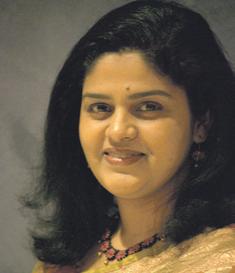
DECEMBER (2) 2013 21 NATIONAL EDITION
s U s TAINABILITy
An ecologically sustainable house designed by an Indian engineer has won accolades across Australia
Sanjiv Gosain (on right) receiving one of his Master Builders’ award
Eight participants, an impressive tally
Students from Delhi’s Tender Heart School are proud winners at the Special Olympics in Newcastle
 BY JYOTI SHANKAR
BY JYOTI SHANKAR
Sometimes life brings you the company of fellow human beings who are such an inspiration, that you feel rejuvenated and proud to be one. Meeting Renu Bali, Kakoli Mukhejee and Katy Fitzgerald, has been one such encounter. However, unfortunately meeting their wards, the eight participants of the Special Olympics AsiaPacific’s Team India from Tender Heart School, was not possible as they were flown straight to Newcastle and back. Tender Heart School is in Bhatola, Haryana, a small village situated 10kms from Faridabad, near Delhi. That these children have overcome their disability and participated in these Games with such success, is something you would like to shout from the rooftops to anyone who cares to listen!
It has been an immense effort on the part of these three women to bring eight children to Australia. Katy, an Australian with a passion for photography and for India, sold her photographs taken in India to raise funds for the travel of these children to the Special Olympics, held at Newcastle from 1 to 7 December. (Her inspiring story was featured in the July 1, 2013 edition of Indian Link). At the opening ceremony, an enthusiastic crowd greeted the smallest teams of athletes from Cambodia and Mongolia, with as much noise as the 398 athletes in the Australian team. Governor-General Quentin Bryce, welcomed 2,500 athletes from more than 32 countries.
Tender Heart is a nongovernment, not-for-profit organisation, started 15 years ago, with the aim of providing social and educational opportunities for disadvantaged children. It provides education to ‘normal’ children from around Bhatola, those with physical and mental disabilities who
need special education, and works on helping to empower women. 200 children and 50 special needs students study and play together in this inclusive school. “With the special needs children, the emphasis is not only on providing an education, but also on making these often rejected people a part and parcel of society,” says Renu Bali, founder of the Tender Heart School.
“I observed a tendency of these children to feel rejected and depressed, and consequently uninclined to participate in any activity. This results in low selfesteem and obesity,” explains Renu. Also observing that given the opportunity, these kids were happy when playing games, Renu wrote to the Special Olympics Bharat committee and got the children started on a games training program organised by them. The first camp at Jammu, attended by these children who had never left home, was a big challenge. Most of them hardly spoke, but Renu says on the second day, she received a call saying that a child wished to speak to her. “Yahan ka paneer bahut acchha hai,” (the water from here is really good) said the child. Renu was stunned to hear this from a child who apparently had no logical thinking, and hardly spoke before. She realised that the travel and participation in games had made this big difference. “After this, I stepped up participation in training camps. These were often held inter-state and I had a tough time convincing parents of children to let them go, but my efforts paid off,” claims Renu. “Each time they came back with new words in their vocabulary and started doing very well at district, state and then national level games,” she adds. Two and a half years later and the doors to international level competition were opened to them, so here they were now – in Australia!
There couldn’t have been a prouder set of people than Renu, Katy and Kakoli (a special educator at Tender Heart School), when the final medal tally was announced. They had no sponsors initially

but kept up with the practice for participants, egged on with a strong determination to make it happen for this special contingent. Amongst themselves, the eight participants won 14 medals! Team Bharat made up of 381 participants, won 387 medals in all. A tremendous achievement considering that able-bodied sportsmen at normal Olympics struggle to win a single medal for India!
Renu wishes to make the efforts of these participants known to the whole of India. “They need to get a hero’s welcome,” says Renu. It is a pity that such adulation is reserved for cricketers and Bollywood stars only, she rues. “My aim is to make these children stand on their feet and sustain themselves.
I am advocating hard for these participants to get cash awards like other Olympic medal winners. This could provide some support, as well as encouragement,” she avers. Speaking of hardships, Renu tells the story of when the school had an opportunity to send a student for the shot putt activity. The problem was, they did not have one. So she asked the child to start by throwing stones, found in abundance around the school. At first he wasn’t happy doing this. “Kyon mujhse patthar phekwate ho,” (‘Why are you making me throw stones?’) he complained, but this practice stood him in good stead and he was ecstatic when he won at shot putt at the state level,
and received a Rs.15,000 cash prize!
One of the participants was Bhupender, and his forte is athletics. Though on the IQ scale, his ability may be only 55, on the running scale, he beat able-bodied people to win gold at the Delhi Marathon. ‘Don’t DISmyABILITY’ is what these achievements cry out.
Not all students from Tender Heart School are ‘children’. The oldest and sole female participant is Aarti who is 32. Participation in each of the sports category is based on ability. Piyush who won the 100m, only wanted to play cricket but Renu’s gentle coaxing worked. “Naye joothe doge to main bhagoonga,” (‘I will run only if you buy me new shoes’) said Piyush, and Renu was more than willing to oblige him with a pair! Other athletes were Deepak, Uttkarsh, Vishesh, Vikram and Keshav, the youngest at eight.
Renu has a bank of ‘success stories’ about these children, and this is what drives her to aim higher. Given the opportunity, these special children can achieve anything. Vikram dropped out of school in Year 7 as his wheelchair was hard to navigate on muddy roads when it rained. He asked Renu if he could learn a vocation.
The girls at the school made soft toys and he started with drafting and cutting templates, which the girls then stitched. During the
course Vikram said he wanted to study again, and so Renu got him a better wheelchair from Red Cross. Vikram has completed his graduation this year in spite of many hurdles. Now international volunteers at Tender Heart are training him in computers as he has been promised a job at Convergys, an IT company, if he is able to upskill in MS Excel.
“We need partners on this hard journey. Our projects should be able to sustain themselves, and only then can they be successful,” says Renu.
Indians in Australia can help these children and many others in their situation by becoming a volunteer at the school, buying products made by them or donating to the Tender Heart Foundation (www.tenderheartngo.org). “There have been many volunteers from Australia and with their help we are trying to upskill our teachers to use better training methods for special needs students. I realise we have a long way to go,” says Renu. “When I saw Australian children speak on the mike before huge crowds at the Special Olympics opening ceremony, all I thought was that I want to make my children do that!” We can all try to make this happen and we don’t have to dig deep into our pockets. As Kakoli put it, “A dollar a day is more than enough to bring up a single child in India”.
22 DECEMBER (2) 2013 www.indianlink.com.au
special report
medals, tally

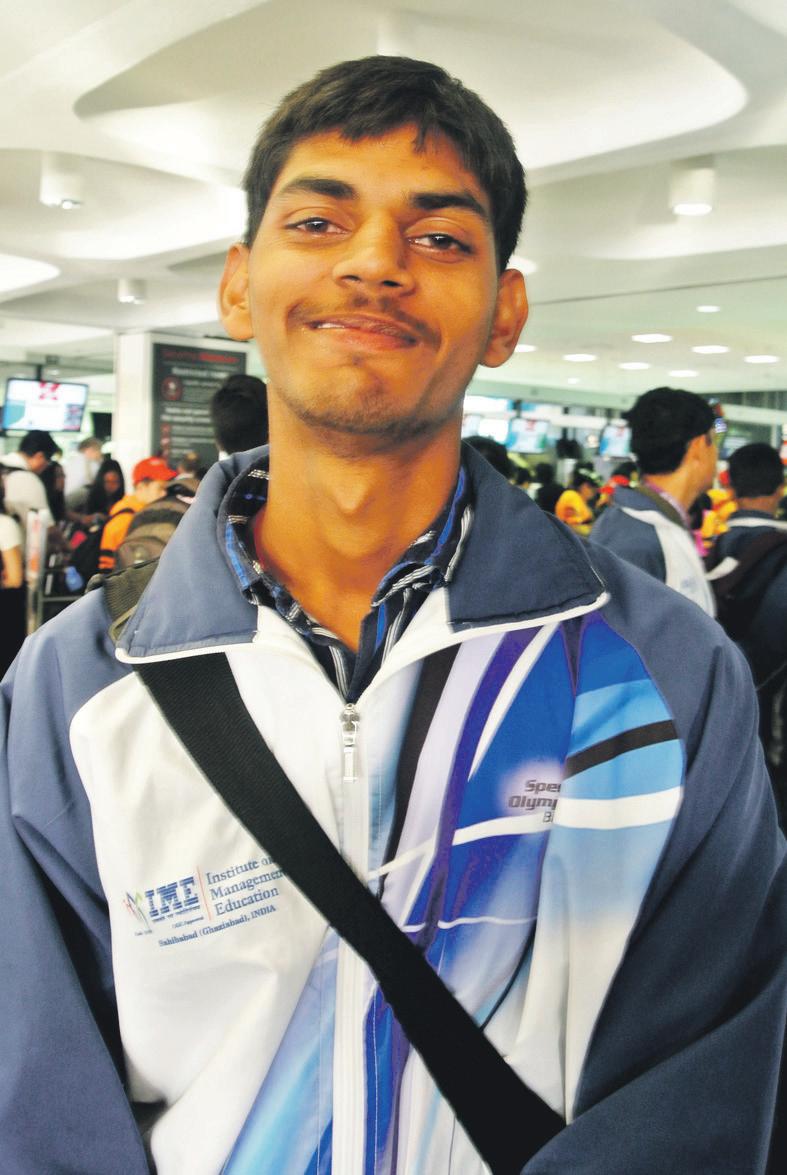

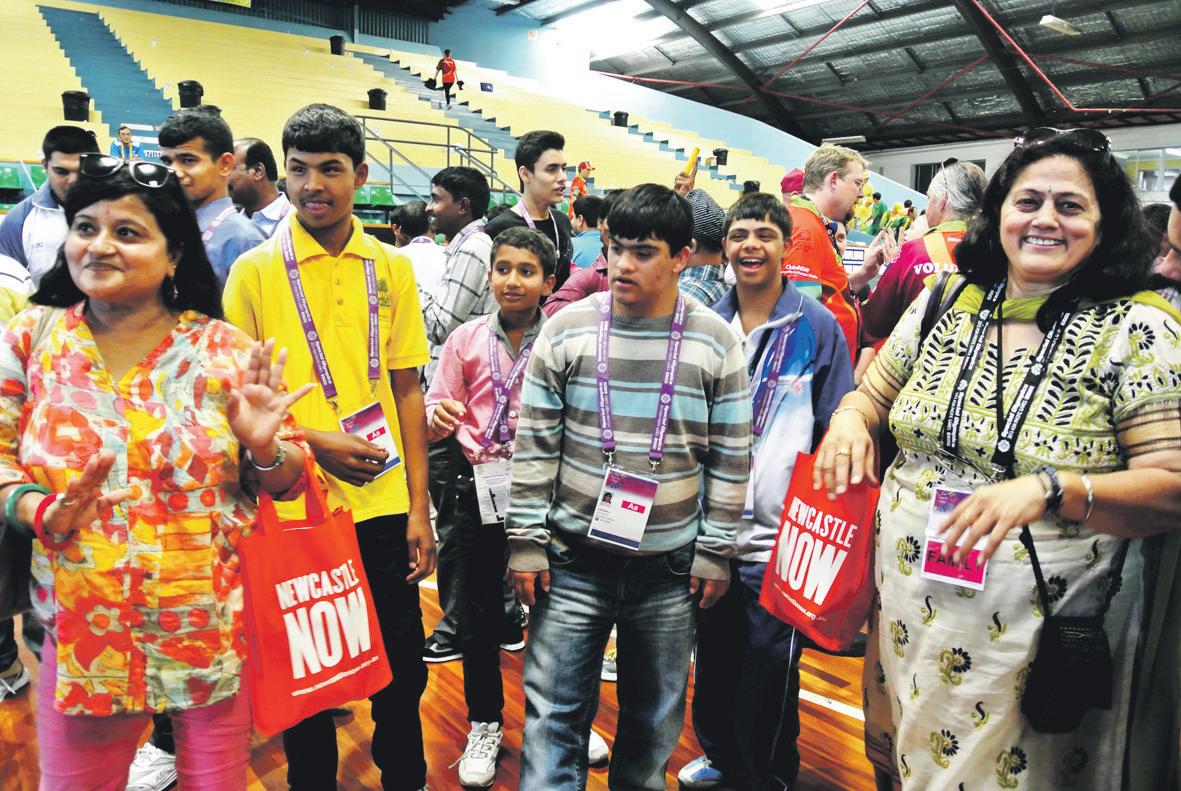
“They need to get a hero’s welcome. It is a pity that such adulation is reserved for cricketers and Bollywood stars only,” Renu Bali

DECEMBER (2) 2013 23 NATIONAL EDITION
participants, fourteen
From Vel to Ezekiel to Capote
A talented
 BY MOHAN DHAll
BY MOHAN DHAll

Vel Subra is the first non-Caucasian to perform the role of Truman Capote, the novelist and literary giant of the 1960s and 1970s, who created classics such as Breakfast at Tiffany’s and In Cold Blood. Subra, under his stage name of Ezekiel Day, is the sole actor and director of the one-man play TRU, which captures the life of troubled, but brilliant Capote. The novelist’s personal life was characterised by a mixture of chaos, literary genius and irony. Born into a chaotic family life, Capote’s early life was marked by the early divorce of his parents, loneliness and change.
Despite his turbulent past, Truman Capote was an extremely focused writer and published Breakfast at Tiffany’s in 1958, followed by the highly successful In Cold Blood – which shot him to national and international fame. Following great success with his writing, Capote found himself a celebrity, mixing with those in the highest social circles, and appearing on television. However Capote never felt comfortable with what he observed and in a novel titled Answered Prayers, he sought to expose his observations of the personal lives of those with whom he found favour. The book was never published. However, Capote did allow excerpts of the book to be published in Esquire magazine in 1975. This was an act of social suicide and led to Capote being excluded from the social scene that had embraced him and
given him both recognition and fame. From this point, Capote slid into a life of drug abuse and dependence on alcohol, dying of liver cancer in 1984.
A quintessential American character, whose life was played out in the changing American post-war culture, Capote’s life in play has only ever been taken on by Caucasian actors. The problem facing Subra as an Indian actor, has been to bring to the stage a sense of reality in a way that who he is, is not a factor in his portrayal of the character of Capote.
For Subra, the role of Capote has been a journey of selfdiscovery. Born in Tanjore in south India, Subra lived in Singapore for a number of years prior to travelling to Australia and living in both Melbourne and Sydney. “I found that through my
acting and in moving between nations, life is a search for belonging and place,” says Subra. In Australia, Subra acts under the stage name ‘Ezekiel Day’, choosing it as he found that his actual name ‘Subramaniam’ would close doors, as Australian theatre has been notoriously colour-blind. “In taking on this role, I have directly imposed myself against the cultural bias I have faced,” reveals Subra. “The motivation for the performance is however, much deeper than simply making a statement about how an actor can find a place, when no place is on offer”.
As a theatre practitioner, Subra has been inspired by Cate Blanchett in her performance as Bob Dylan. In this case, Cate was so convincing in her male role that she won a Golden Globe. Cate has observed the approach to work
taken by brilliant Indian director Shekhar Kapur who begins his work with prasadum, the making of an offering to the divine, prior to undertaking a task. So too does Subra, who takes a spiritual approach to his craft, while seeking to transcend boundaries.
“The role of Capote is extraordinarily demanding and risk-laden,” admits Subra. “A less than convincing performance would not do me any favours, and it is thus, a considerable gamble However, I have embraced the challenge and in doing so, I seek to inspire others,” he states determinedly.
Subra originally played the role of Capote in Singapore in 2012, where it was a success. However, Singapore is a less risky performance space as the audience are more exposed to cultural diversity, than they are in Australia. Risk has been mitigated somewhat through extensive research. “Over a period of seven months, I have studied the works and the mannerisms of Capote, practising his voice, gestures, use of words and accent. The aim, of course, is to bring authenticity to the performance,” claims Subra.
Subra is placing himself into an unmediated space, the only actor and director in a play that lasts 100 minutes. Here we have Subramaniam Velayutham, with stage name Ezekiel Day, playing Truman Capote, who himself was born as Truman Streckfus Persons. The only question that remains is whether Subra can find himself and in that sense, truly ‘arrive’ in Australian theatre. He who seeks to transcend cultural boundaries with a performance premised on an offering to the Gods may have his prayers answered.
In Australia, Suba acts under the stage name ‘Ezekiel Day’, choosing it as he found that his actual name ‘Subramaniam’ would close doors, as Australian theatre has been notoriously colour-blind

Here we have Subramaniam Velayutham, with stage name Ezekiel Day, playing Truman Capote, who himself was born as Truman Streckfus Persons.

24 DECEMBER (2) 2013 www.indianlink.com.au
people
Indian origin actor brings his craft to the stage in a challenging role played and directed by himself
Vel Subra
Australia honours Aung San Suu Kyi
A renowned human rights activist expresses her thoughts and feelings during a felicitation by leading universities
“My attitude to peace is rather based on the Burmese definition of peace - it really means removing all the negative factors that destroy peace in this world,” once remarked Nobel Peace Prize winner and prodemocracy activist Daw Aung San Suu Kyi. The essence of this quote of Ms Suu Kyi was reflected in almost all of the addresses she delivered during her recent maiden visit to Australia, to encourage global interest in democratic reform in her country Myanmar, formerly known as Burma.
As expected, Ms Suu Kyi’s six day official schedule from November 27 upto December 2 was packed with engagements that included meeting Prime Minister Tony Abbott, Foreign Minister Julia Bishop, Governor General Quentin Bruce, members of Myanmar community and receiving honorary doctorates from three top universities, Sydney University, University of Technology, Sydney and Australian National University in Canberra.

Sydney University and UTS jointly conferred the respective honours at a function held at the

concert hall of Sydney Opera House where every available seat was filled, signifying the immense popularity of a person who has dedicated her life to peace, human rights and democracy. It is interesting to note that the last time the two universities held a joint degree ceremony was to honour another global inspiration leader, Nelson Mandela.
Ms Suu Kyi now 68, is fittingly compared with Gandhi, Mandela and Martin Luther King. Like them, she is a keen follower of non-violence, liberation, equality and justice. Her strength to lead and inspire people naturally comes
from her father General Aung San who fought for Burma’s independence from the British in 1947, but was unfortunately assassinated in 1955.
After her father’s death Ms Suu Kyi lived abroad in India, England and United States and returned Burma in 1988 to take care of her ill mother, leaving behind her husband and two sons in England. At that time, Burma was passing through a period of great political turmoil and stood behind the people fighting for their democratic rights. She was soon held under house arrest and achieved unconditional
Ms Suu Kyi, now 68, is fittingly compared with Gandhi, Mandela and Martin Luther King. Like them, she is a keen follower of nonviolence, liberation, equality and justice
release only in 2002.

Many of Ms Suu Kyi’s thoughts and feelings came out when she spoke at the Sydney Opera House after receiving the university honours. She talked about relationship with her father, the choices she opted for in her personal life and about the three pillars on which she sees Myanmar united and reformed, democracy, human rights and national reconciliation. When questioned on Australia’s asylum seeker policy, she said justice should be tempered with mercy, reflecting again her thoughts on peace and humanity.
When questioned on Australia’s asylum seeker policy, she said justice should be tempered with mercy, reflecting again her thoughts on peace and humanity
DECEMBER (2) 2013 25 NATIONAL EDITION Pl Call on: 0434 643 376 Indian Grocery for Sale in western suburbs 8 years old, good customer base Ample parking Serious Buyers Only No time wasters 100K + Stock (Negotiable)
people
ADVICE SINCE
Victor
BMc MiGratioN coNsUltaNts eimmigration Registered Migration Agent 9901093, Civil Marriage Celebrant A5147 Member: Migration Institute of Australia, Migration Alliance 269 Pacific Highway Hornsby NSW 2077 Mob: 0412 268 568 Tel/Fax: 02 9940 4430 email: bmcvisa@gmail.com All types of Work Visas Employer, State Sponsored Visas Regional Sponsored Visa (RSMS) Religious Worker Visa Partner, De-facto, same sex visa EOI, All types of Skill Visas Domestic Violence Partner Visa Carer Visa Student Visa Parent Visa Child/adoption Visa Remaining Relative Visa Sponsored Visitor Visa MRT, RRT Reviews Ministerial Appeals All Skill Assessments
SANDIP HOR
IMMIGRATION & VISA
1999
S. lamba



26 DECEMBER (2) 2013 www.indianlink.com.au
Indo-Oz fund to invest millions in film industry


The newly formed AIFF will nurture understanding between the two countries through films, serial and documentaries
In what will be a stupendous boost to the Indo-Australian film industry here, a group of Australian entrepreneurs of Indian origin headed by Sydney-based investor Devendra Gupta, have recently announced the formation of the Australian India Film Fund (AIIF), a private venture that will finance Indo-Aussie feature films, documentaries and television shows.
Utilising the 40% producer’s offset, a tax rebate meant for productions that have “significant Australian content,” the fund will trigger several million dollars worth of production and proposes to finance one Australian feature and one TV series or documentary in the next 18 months.
“We are very excited to announce this venture,” stated Yateendra Gupta, CFO of the AIFF. “With growing numbers of professional Australian investors of Indian origin, the investorfriendly Australian film space and the success of India centric western films, we are anticipating a long term presence supporting Australian stories. We want to nurture understanding between India and Australia through the films and documentaries we decide to fund,” he added.
Australia’s leading film professional working with India, Anupam Sharma, has been appointed as AIFF’s Head of Films. Also on board is Fox Studio-based Company, Films & Casting TEMPLE to produce the Fund’s investment in Australian screen content. “It is important for us to entrust our finances and resources in professional hands with impeccable reputation,” said Mr Gupta. Anupam Sharma “has an enviable reputation for professionalism over hundreds of Australia-India projects,” he further explained.
Anupam Sharma spoke to Indian Link about his involvement in the venture and the future
he envisages for the AIFF.
Mr Sharma has recently been appointed as the Australia Day Ambassador and has directed several top Bollywood movies like Dil Chahta Hai and Heyy Babyy, which were shot in Australia. He also holds a Masters degree in Film and Theatre from the University of New South Wales.
“We believe it is the right time to invest in the Australian film industry’s niche projects and redefine the form and content of an ‘Australian Story,’” stated Mr Sharma. “India-centric stories like the UK’s Bend it Like Beckham have resonated with global audiences, and we hope to do the same from Australia. We have professional crews, a producer’s offset and a strong Indian diaspora. With this fund, Australia can be more than just a service provider for the Indian film industry, but an active participant in India-centric film projects,” he explained.
With at least 90% of the crew and 80% of the cast being local and a high percentage of shooting done in Australia, the very best case scenario is the AIFF funding a feature and a documentary every year for years to come. This has obvious benefits for Australian professionals in films specially
those of Indian origin. “One of the keys for a good film is getting independent finance to maintain independence of creativity,” stated Mr Sharma.
So what are the major themes of movies and documentaries on which the fund will focus? “There is no preset agenda. We will be looking at good stories which are Australian and combining the Australian body with the Indian soul. The production set up, completion bonds, accounting structures, distribution, international sales etc. etc., will all be as per western standards. The emotions, the colour, the music, the soul will be Indian,” explained Mr Sharma.
He further reiterated that all aspects of modern Australian culture which has intriguing stories, will be considered, whether they are of Indian, Pakistani or Bangladeshi Australians, which are now Australian stories. So will such a venture help to recognise, acknowledge and even create Indo-Aus identities among people who belong to both countries? “I think such identities already exist. Mainstream films between India and Australia will legitimise such identities and bring them out of the ‘ethnic pigeonhole’,” said Mr Sharma,
also stating that the AIFF could raise issues and voices about say, domestic violence or student issues.
The directors of AIFF have been impressed with the outcome of their months of research which confirm that there is a high level of transparency, security, and financial benefits in the Australian film space. Film and media are proven to be effective tools for better bilateral relations between two nations.
This much-needed injection of private investment into the local film industry has been enthusiastically welcomed. “AIFF’s decision to completely fund projects will also hopefully take financial pressure off agencies such as Screen Australia who have been so enthusiastically pushing better links between India and Australia,” said Mr Sharma.
Screen Australia’s CEO, Graeme Mason said, “It’s terrific to see more opportunities for Australian filmmakers to explore stories with a unique viewpoint. India and Australia have great shared stories to tell”.
Commitments are in place for initial projects, and applications will soon be invited for ongoing funding rounds. The first projects are expected to be announced in the new year.
The fund will trigger several million dollars worth of production and proposes to finance one Australian feature and one TV series or documentary in the next 18 months
“We will be looking at good stories which are Australian and combining the Australian body with the Indian soul”
DECEMBER (2) 2013 27 NATIONAL EDITION
ARTS
Anupam Sharma
IK a r aO
Anupam Sharma and Hugh Jackman
Delhiites pay homage to Damini, the name given by the Indian media to the Delhi rape victim, at Jantar Mantar on 16 December. Events across the Indian capital marked the anniversary of the fatal gang rape of a 23-year-old student, which provoked widespread outrage and led to stricter laws against sexual assault

Anti-apartheid icon Nelson Mandela laid
to rest
The world’s anti-apartheid icon and South Africa’s first non-white president Nelson Mandela was laid to rest on Dec 15 at his ancestral home in Qunu village in Eastern Cape province at a state funeral.
Mandela’s body was placed in his final resting place, alongside his other family members at the Mandela family farm in rural Qunu, South Africa’s government news agency SA News reported.
Traditional rituals were performed to ensure Mandela is received by his ancestors.
The funeral marked the end of a 10-day mourning period, declared by President Jacob Zuma after the elderly statesman passed away at his home Dec 5 in Houghton, Johannesburg at the age of 95.
Following a beautiful and sombre funeral service at a specially-erected marquee earlier, Mandela’s body, draped in the South African national flag, was taken to the family farm.
Once the family members and president were seated, military officials undraped the casket and the flag was ceremoniously folded and handed to Zuma, who handed it to Mandela’s widow Graca Machel.
The national anthem was played and the South African Air Force flew a salute flight before the last post was sounded.
The burial itself was not telecast and no pictures were allowed - to afford the family and dignitaries to say their personal and final goodbyes in private.
Earlier, speakers hailed Mandela at the funeral service, with all paying moving tributes to South Africa’s first democratically elected non-white president.
Among the dignitaries present were current and former heads of state and other eminent people, including Britain’s Prince Charles, Reverend Jesse Jackson, Sinn Féin leader Gerry Adams, businessman Richard Branson and talk show host Oprah Winfrey.
South Africa’s Nobel Peace laureate Archbishop Desmond Tutu also attended Mandela’s funeral. Earlier, Tutu said he cancelled his flight to the Eastern Cape to attend Mandela’s funeral after he received no indication that his name was on the guest list.
South African President Jacob Zuma said the government and the country will take forward the legacy of Mandela. Zuma also thanked the Mandela family for their perseverance over the years when the
world icon spent 27 years in jail during the apartheid regime.
“As your journey today, ours must continue. One thing we can assure you today, as you take your final steps, is that South Africa will continue to rise,” Zuma said.
Describing Mandela as a “fountain of wisdom, pillar of strength and a beacon of hope,” Zuma said Mandela taught the country to live together, regardless of race.
Ahmed Kathrada, the Indian-origin veteran anti-apartheid activist and for years aide to Nelson Mandela, moved many mourners to tears when he paid a poignant tribute to the late statesman.
“When Walter (Sisulu) died, I lost a father, when you died I lost a brother, now I don’t know who to turn to,” Kathrada said, facing Mandela’s casket.
Walter Sisulu was a South African antiapartheid activist and member of the African National Congress (ANC). Kathrada and Mandela were both imprisoned in Robben Island for their political views.
Malawi’s President Joyce Banda said she was inspired by Mandela, who had a spirit of forgiveness.
African Union chair and Ethiopian Prime Minister Hailemariam Desalegn said Mandela’s life was a record of all the trials the African countries had to endure under colonialism.
Tanzania’s President Jakaya Kikwete said the people of Tanzania have lost a great friend, a great comrade in arms.
Over a lakh Muslims take pledge against terror
Over one lakh Muslims recently took an oath against terrorism and to spread the message that Islam is a religion of peace and has always promoted harmony.
The ceremony, organised by the Jamiate-Ulema-e-Hind, was held at the Ramlila ground in New Delhi, and came after a twoday conference attended by clerics of Jamiate-Ulemas in the Maldives, Britain, Sri Lanka, Pakistan, Nepal, Bangladesh and Myanmar at Deoband in Uttar Pradesh’s Saharanpur district, where it was decided to set up a forum to promote world peace.
“The forum will help promote peace and make the entire world understand that the motive of Islam is to promote peace and harmony. Islam has always wanted that peace prevails in the world,” Jamiat-e-Ulema
general secretary Maulana Arshad Madani said in address in the capital.
Only better understanding and a proper universal brotherhood will bridge the rift among people and let the world live in peace, he added.
“Freedom is the basic human right of every person in the world and by spreading terrorism, a lot of organisations have just tried to sabotage tranquillity prevailing in the world,” said Maulana Madani.
Speaking on the occasion, Jamiat-e-UlemaPakistan (Fazlur) chief Fazlur Rahman maintained that peace cannot prevail as long as “atrocities are done on the people by the dictators in a society”.
“Today the issue of terrorism is not just limited to Afghanistan and Pakistan but has affected almost all the nations of the world, which has made it immensely important for the people to come together and tackle all such sort of issues to let peace prevail in the society,” he said.
30 years in making, Tejas finally ready for production
Three decades after the project started, India’s Light Combat Aircraft (LCA) Tejas is all set for initial operational clearance and production, Defence Research and Development Organisation (DRDO) chief Avinash Chander said recently in New Delhi.
The DRDO got permission to start the programme to design and develop an indigenous Light Combat Aircraft way back in 1983.
“The ten-tonne category indigenous Tejas has gone through the full operational envelop of its speed, angle of attack, different manoeuvres it can make, different types of loads it can carry, weather conditions and high altitude operations,” Chander, who also serves as scientific advisor to the defence minister, said in an interview to the “War and Peace” program of state-run TV channel Doordarshan News.
“It gives us the confidence that the aircraft is now ready for production (at the facilities of Hindustan Aeronautics Ltd). HAL has been chosen as its production agency,” he said.
Chander made it clear that Tejas would continue its production cycles with imported American GE engines.
“If you see the world, aircraft are built
around a proven engine and once it is a flying aircraft, we seldom change the engine,” he said.
Asked whether there could be any hurdles in production because of the imported American engines, he said: “Given our relationship with different countries in the world, we don’t anticipate any problems”.
Chander said the indigenous Kaveri engine project would continue for future unmanned aerial vehicles.
“It will be possible for unmanned aerial vehicles to take off from naval platforms like the INS Jalashwa,” he said.
For the next round of indigenous 20-tonne category medium combat aircraft project, India “will go for some technology partnership to develop some new engine of that class of aircraft,” said the DRDO chief.
‘Sheriff of Wall Street’ Preet Bharara strikes again
Manhattan’s US Attorney Preetinder Singh “Preet” Bharara, dubbed “Sheriff of Wall Street” by Time magazine, has struck again with the arrest of a senior Indian diplomat on charges of visa fraud and exploiting her housekeeper.
But Devyani Khobragade, 39, India’s Deputy Consul General in New York, accused of making her babysitter work for peanuts is not the first Indian to be prosecuted by the famous Indian American attorney whose exploits put him on the cover of Time in 2012. His most famous ‘victims’ in a four-year insider trading crackdown that has won him a record 76 convictions, include India-born former Goldman Sachs director Rajat Gupta and his Sri Lankan hedge fund billionaire friend Raj Rajaratnam.
The Rajaratnam case also brought down former McKinsey & Company senior executives Anil Kumar, Rajiv Goel, a midlevel Intel Capital executive.
In November 2013, Bharara made former Indian internet analyst Sandeep Aggarwal plead guilty to providing inside information about a pending deal between Microsoft and Yahoo to a portfolio manager at SAC Capital.
Then in the second week of December, Bharara charged 49 Russian diplomats and their spouses with scamming Medicaid, a government health care programme for low-income families out of $1.5 million over a decade.
The 49 current or former Russian diplomats and their spouses living in New York City were accused of participating in a widespread fraud scheme to illegally obtain benefits under Medicaid.
No respecter of riches or fame, Harvardeducated Bharara, 45, has vowed to keep up his crusade, saying he has the “greatest job in the world” though he will “walk the earth and get into adventures” whenever he retires.
Badal, Sharif agree to boost cooperation between Punjabs
Indian and Pakistani Punjab’s chief ministers, Parkash Singh Badal and Shahbaz Sharif respectively, recently agreed to boost cooperation, including through exchange of academicians, and people to people contacts between their two regions.
A joint statement from Amritsar said that both sides during their talks agreed “to promote cooperation for the common interest of peace, harmony, economic growth and leveraging each other’s potential”.
28 DECEMBER (2) 2013 www.indianlink.com.au INDIAN NEWS
PHOTO: AP
i ND ia N N e Ws
Both agreed to facilitate exchange of academicians, experts and researches; promote people to people contacts through sports, cultural and tourism activities; pursue policies for easy access for people of both sides to religious places of their respective faith; pursue policies to reduce trade barriers among other things.
Both the chief ministers resolved to pursue with their respective federal/ union governments to facilitate enhanced cooperation and formulate supportive policies in this regard, the joint statement said.
Sharif visited India from Dec 13-15 on the invitation of Badal.
Textbooks need to be rewritten to present science properly
Stressing the need to rewrite textbooks so as to impart a deep knowledge of science, technology and society in the proper perspective, IIT-Kharagpur director Partha Pratim Chakrabarty recently said it was the only way to keep pace with the changing times.
“Our education system has not been able to keep pace with the double exponential growth of technology and rate of knowledge generation. Knowledge and education has become compartmentalised in most institutions. As a result, people have deep knowledge of certain things but have very little knowledge of connected things,” Chakrabarty said delivering the The L.N. Birla Memorial Lecture at the Calcutta Business School in Kolkata.
He regretted that “almost all textbooks” have become backdated in the wake of the high growth of knowledge generation and rate of requirement and changes in the industry and the world.
“There is a need to rewrite the text books so that deep knowledge of science, technology and society are presented in proper perspective. Technology development has forced education to change in a wrong way,” he said.
Commenting on the topic of sustainability, Chakrabarty called for convergence of knowledge.
“We are not aware of global problems because we are busy solving only local problems. Today we have the power given by knowledge to play with nature and we have all messed it up due to a lack of convergence of knowledge. Most of the disasters that are occurring today are man made. The kind of scientific research that we have done has been focused for the few and the elite. This trend has only recently begun to change and the reason is the recognition of the fact that there is inevitable science of danger of unsustainable growth”.
In his speech, CBS chairman S.K. Birla said, “In spite of the earlier radical differences within societies, the trend today is veering slowly towards the thought processes of various countries to meld together and we can no longer afford to think and act in isolation”.
India should learn from African model on wildlife conservation: Valmik Thapar
At the beginning of the 20th century, there were an estimated 40,000 tigers in India, but this count has now reduced to a meagre 1,706. It is an alarming figure, but tiger conservationist Valmik Thapar hasn’t given up yet.
He feels the national animal can be saved by adapting innovative wildlife tourism modules practised in Africa and by revamping age-old recruitment processes.
“We should learn from Africa. Their wildlife policies allow locals to manage a large part of the land for wildlife. We don’t even match up to the ‘A’ of Africa when it comes to preserving and conserving our wildlife. Their forest departments try all possible models a human mind can think of,” Thapar said recently in New Delhi.
“Their Masai Mara park in Kenya is one of the best and successful modules. Local people, resort owners and the government work together in partnership and locals get a share when tourists come to the park. This way, locals get more than $100 million a year from revenue generated from tourism. This is innovative tourism of not ruling but serving, something that is obsolete in our system,” he added.
According to the tiger census of 2010, the big cat’s number has dwindled to 1,706, but the 61-year-old conservationist in his new book, The Last Tigers, published by Aleph, dismisses this figure and said the number was a mere 1,000 to 1,200.
Thapar, who established the Ranthambore Foundation in 1987 along with a nongovernment organisation connecting all those who wanted to save tigers, from locals to individuals and governments, has also drawn a blueprint for the Ranthambore National Park in Rajasthan where only 26 tigers are left.
He has also discussed the changes he wishes to see in the recruitment process of Indian Forest Service (IFS), a force whose role involves wildlife management, soil conservation, surveying, and handling weapons.
Other than talking about his favourite animal, Thapar has openly pointed out in his book about bureaucratic struggles during his stint in the government.
“Our system of recruitment in the forest department is extremely outdated, and we still follow British course structure... like how to cut a tree? We don’t teach them anything about protecting wildlife. During my research for the book, I realised that even after independence, we haven’t changed our course and just inherited it! The Britishers’ system was to exploit us. They would cut
forests to boost their economy. So you have to change the course of training and recruitment. I feel we never paused to change the system and that is what I believe is essential. If we have good wildlife parks then we need an Indian wildlife service,” he said.
He said the worst the government could do is to fail to appoint right people for the job.
A bible of sorts, this anthology has narratives from many international and national wildlife observers, covering the period from the 16th century to the early 20th century.
The book is complemented with candid photographs and sketches of the big cats.
Author of over 20 books, with thousands of pictures and several documentaries and films to his credit, Thapar was appointed a member of the Tiger Task Force in 2005, a stint he candidly admits as a “complete waste of time”.
“Those 21 years didn’t do any good to me or to the tigers. It was all about discussions, meetings and policies... there was no implementation,” he said.
Defeated, but not crushed by the suffocating bureaucracy, he believes if state governments are passionate about wildlife conservation, they can change these bleak figures into magical numbers and provide a successful model of tiger conservation plan for other states to follow.
“Once a chief minister of any state provides a successful module of wildlife protection in his state, only then we will have an example to show others the working module that can benefit locals, tourism and wildlife,” he said.
“Probably the best would be like we outsourced our airports and worked with private partners. Time has come to join hands with private experts who can change our poor wildlife conservation for good,” Thapar said.
Free insulin for poor children in Delhi
Many diabetic children from the economically weaker sections of the society in the national capital will be provided insulin free of cost, said a Delhi based diabetic centre recently.

Delhi Diabetic Research Center (DDRC)
will provide insulin free of cost to 150 poor children suffering from Type 1 diabetics.
The initiative was announced by DDRC at a day-long event at Talkatora Stadium in New Delhi.
“Children with Type 1 diabetes need a daily dose of insulin, regular monitoring of glucose levels, periodic visits to the doctors and subsequent pathology tests, which becomes a bit unaffordable for the weaker section of the society,” said Ashok Jhingan, diabetologist and chairman, DDRC.
All the children provided free insulin are between the age group of 0-18.
“Initially we will provide free insulin to 150 children and slowly shall extend the reach to more children,” Jinghan added.
Jammu to be made major golf destination: Farooq Abdullah
Jammu will be promoted as a major golfing destination in the coming days, union Renewable Energy Minister Farooq Abdullah said recently.
Speaking at the end of the two-day golf championship at Sidhra golf course in Jammu, Abdullah, a former Jammu and Kashmir chief minister, said, “Jammu will be promoted as a major golfing destination in coming days as the golf course at Sidhra is being developed as one of the world’s finest golf courses”.
About 200 golfers from all over the country including 45 from Kashmir participated in the tournament.
Abdullah said he appreciated the tourism department and J&K golf association for organising the tournament and urged for organising such events on regular basis.
“In fact, golf tournaments in Jammu need to be organised every weekend. This will not only popularise the golf game, but will make Jammu as a great golfing destination.
About one crore pilgrims visit Mata Vaishno Devi cave shrine annually which includes many golfers who could be diverted to stay at Jammu for playing golf. The tourism department should explore all possibilities in this regard. Both the central and state governments would provide all logistic support for the purpose,” he assured.
The tournament was organised in three categories including senior golfers, juniors and children. Abdullah also gave away trophies to the winners.
DECEMBER (2) 2013 29 NATIONAL EDITION
PHOTO: AP
IANS
Members of the LGBT (Lesbian, Gay, Bisexual and Transgender) and sexual minorities participate in a protest against the Supreme Court verdict on homosexuality, in Mumbai, 15 December. India’s Supreme Court upheld a colonial-era, anti-gay sex law, dealing a setback to the gay, lesbian and transgender communities. A two-judge bench of the Supreme Court reversed a landmark 2009 verdict by the Delhi High Court
The year that
We take a quick look at the major events that defined the year including weather woes, political movement, arrivals and departures, and the creation of the selfie
South Wales devastated land, flora and fauna, and homes. Sydney was enveloped in a haze of smoke and dust, that took days to clear.
Manmade mayhem
2013 is on its way out, and what a year it has been! We’ve experienced high political drama, devastating natural disasters, random acts of terrorism, births, deaths – all the ingredients that make an interesting and varied year, but one that we will be glad to confine to the annals of history. So here are some of the most significant events of the year gone by, and let’s hope that 2014 brings the world peace, prosperity and contentment.
Happy New Year!
What’s with the world?
Some things haven’t changed. Like the civil unrest in the Middle East, with Syria giving the world at large a scare with to its use of chemical weapons. But progress has been made with the US removing some sanctions on Iran, a sign of good things to come.
Barack Obama is now in his second Presidential term, but the US shutdown has been a challenging situation, as has the spying scandal for which America is still sheepishly apologising. Unlike our very own PM Tony Abbott who’s tough stance and refusal to apologise to the Indonesian government came as a surprise to political pundits. An unpublished letter from him to Susilo Bambang Yudhoyono seems to have resulted in a status quo.
The Global Financial Crisis continues, but it seems like everyone’s simply tired of talking about it. Let’s move on, seems to be the common sentiment, and about time too!
Weather woes
Natural disasters seem to have abounded in 2013, with a devastating typhoon in the Philippines which resulted in a massive loss of life. The floods in Uttarakand in India also caused mayhem. Closer home, widespread bushfires in New

The year did not start on a good note with the Brazilian nightclub fire disaster in which many lives were lost, followed by the Boston Marathon bombing, sending the US into a spiral of fear once again. Later, the Kenya mall attack by extremists brought to light the ugly strength and reach of terrorism. Asia was in the news with a tragic factory collapse in Bangladesh, and we cannot even list the numerous bomb blasts across Iraq, Afghanistan, Pakistan and Syria, among other countries, where such incidents have, tragically, become commonplace.
Australian antics
For Australia, 2013 heralded political change with the federal elections being won by a clear majority by the Liberal party. Labor lost with Kevin Rudd back in the hotseat, having ousted Julia Gillard in a non-spectacular coup.

Prime Minister Abbott is already mired in the spying scandal, there seems to be dithering in relation to asylum seekers and the polls are being unkind. It wouldn’t be surprising to find Mr Abbott giving 2013 a rousing farewell!
Oddly, the media have been wasting space covering the antics of Lara Bingle, Tom Waterhouse, James Packer and any sporting celebrity you could possibly think of.
But the Australian cricket team is on a high, having resoundingly thrashed the Poms to win the first two Ashes Test matches. We’ve already forgiven and forgotten their defeat to India earlier this year!
Same sex couples celebrated the (brief) legalisation of same sex marriages in Australia, with 46 couples exchanging vows recently in Canberra.
Rest in peace
Nelson Mandela, social activist and past President of the Republic of South Africa, died at 95, whose memorial service was attended by a huge contingent of world leaders and celebrities. The world
joined South Africa in celebrating his life, lived with dignity and his incredible journey to end apartheid in his country.
The death of Margaret Thatcher, past Prime Minister of the UK, aka the ‘Iron Lady’ was celebrated too by vocal and disgruntled people, in what was to be viewed as one of Britain’s more embarrassing moments.
Arrival and departure
The much anticipated royal baby was born and christened, and Prince George now becomes the fourth heir to the throne of England, also presenting the media with stories and speculation for the rest of his life, bless him!
Sachin Tendulkar has finally retired from Test cricket, to a tumultuous farewell. Now all that remains is to make him a minister or build a temple to honour his name!
Pope Benedict XIV resigned in February 2013, becoming the first Pope to resign his position in 600 years. But the newly elected Pope Francis, head of the Catholic Church, has been creating historic inroads within the Vatican.
Numerous signs of his humility, empathy and kindness have created a renewed interest in the Church by Catholics around the world. And surprisingly, he tops the list of the world’s most talked about topics on Facebook!
Diaspora’s doings
The Indian diaspora has been in the news with a record number of Indian-origin candidates standing

for elections to the House of Representatives and the Senate.
An award for local event of the year could unanimously be awarded to the Hindu Council’s Diwali Mela, which was wellpresented and offered a glimpse of the festival to Sydneysiders.
Shahrukh Khan’s performance with Bollywood belles Madhuri Dixit, Rani Mukherji and Jaqueline Fernandes lent a fitting touch of glamour to Parramasala 2013.
But the most important event of 2013 turned out to be a nonevent, as the Bharatiya Pravasi Diwas held in Sydney resulted
in a poor turnout and nonparticipation by the diaspora. But hopes are high with Tony Abbott’s visit to India on his agenda for 2014, which could result in the Indian diaspora taking on new and exciting challenges in the mainstream of industry and politics.
Award winning streak!
It has been an incredibly busy year for Indian Link, as we carried away numerous awards at the NSW Parliament’s Multicultural Media Awards and Parliament of NSW Multicultural Media Awards.
Selfie centRAl
Dictionary, pronounced ‘selfie’ the word of the year for 2013. Everyone from Obama to Pope Francis, to Miley Cyrus has posed and posted selfies, so why not you?
Indian Link announces the Special Selfie Contest, where your photograph could win tickets to Sydney Festival’s Band of Magicians

Visit: www.indianlink.com.au/best-selfie-of-the-year-comp
ENTRIES CLOSE: JANUARY 2, 2014
30 DECEMBER (2) 2013 www.indianlink.com.au
THE YEAR IN REVIEW
SHERYL DIXIT
that was... 2013

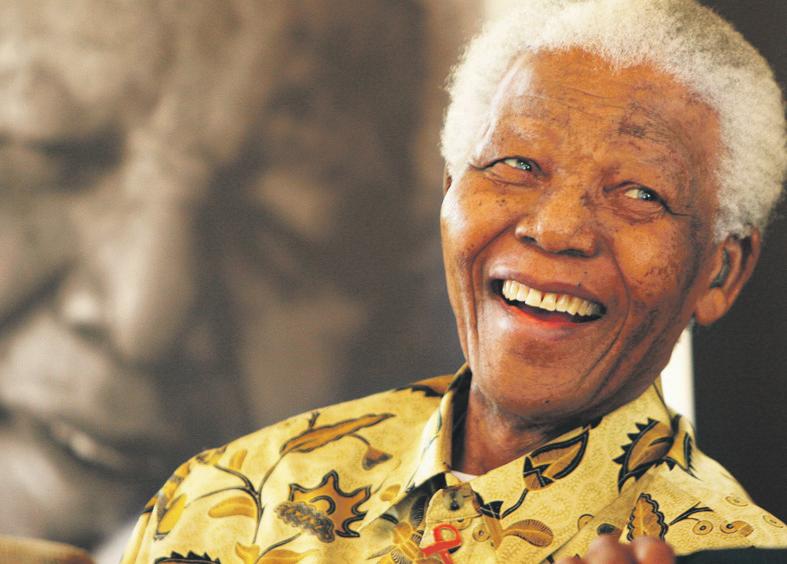



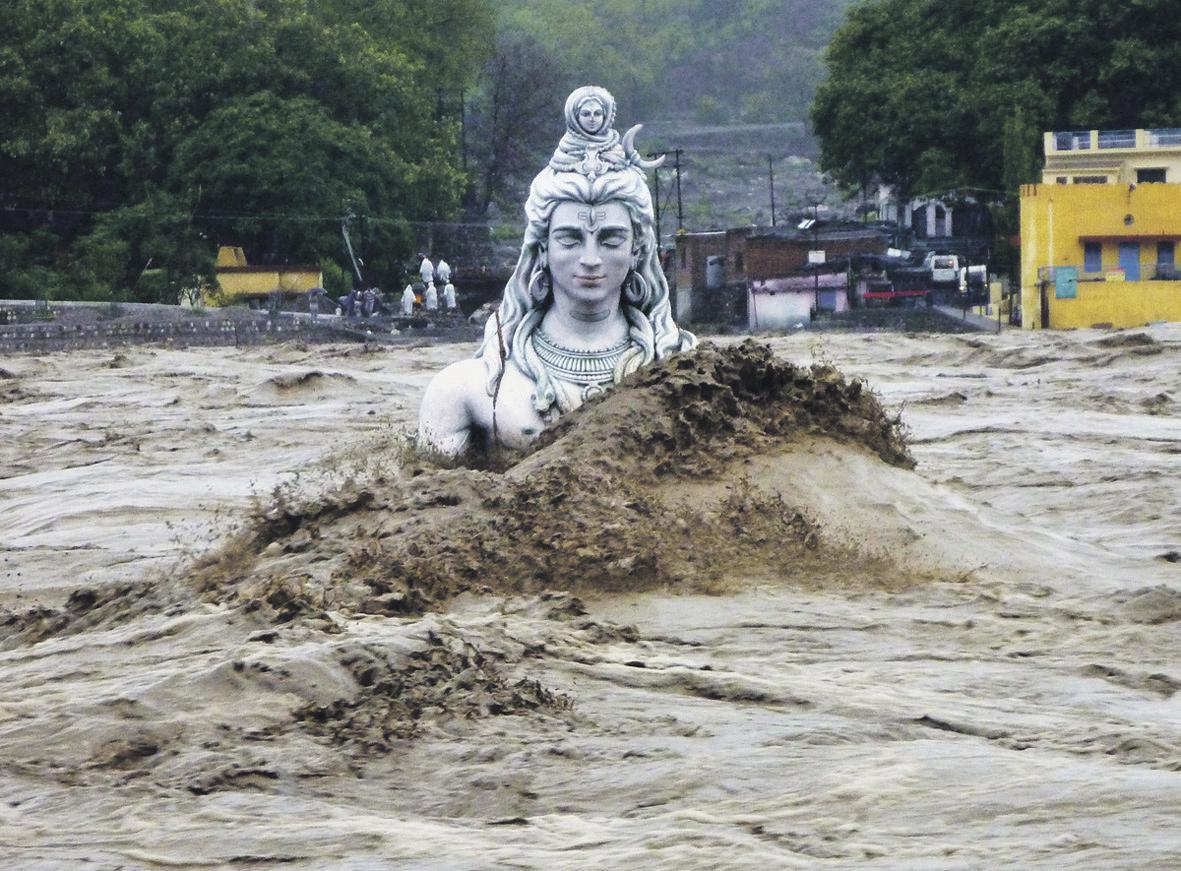



It has been an incredibly busy year for Indian Link, as we carried away numerous awards at the NSW Parliament’s Multicultural Media Awards and Parliament of NSW Multicultural Media Awards

DECEMBER (2) 2013 31
War clouds are gathering in Asia
BY NOEl G DE SOUZA
While Xmas is approaching, there are two dissimilar trends gathering pace in East Asia. One is the anticipation of big pre-Xmas sales in large stores. The other is the perplexing flexing of muscles by China in two theatres of operation. China has declared a large chunk of the Pacific Ocean close to Japan, Taiwan and the island of Guam as a restricted maritime zone in which ‘intruding’ ships and aircraft will have to report their presence to China. The other is a set of islands in the southern seas.
China and by several Southeast Asian nations. Part of the blame might have to be lain at the feet of Western geographers. The southern zone lies in what European cartographers of the eighteenth and nineteenth centuries denominated as the ‘South China Sea’.
is believed that billions of tons of such fossil fuels lie embedded in exploitable geologic structures
In both cases, the marine theatres with the islands in question are mostly rocks that just jut out over the sea during high tides. But whether these islands can be inhabited is not the point; they could be just dots in the sea, but the resources around them is what matters. Troubles in the past used to be over fishing rights, but the prize now is much higher. It is the much more valuable petroleum and gas deposits. It is believed that billions of tons of such fossil fuels lie embedded in exploitable geologic structures.
China’s restricted identification space in the northern Pacific brings the country into direct confrontation with Japan and the USA, who have chosen to ignore the Chinese diktat by flying large planes over the so-called ‘exclusion zone’. This style of engagement possibly reminds the Chinese of the gunboat diplomacy of the nineteenth century when China lost Hong Kong and Macau to the British and the Portuguese respectively. At that time around the mid-19th century, Japan was forced, by use of an American naval fleet, to open to the USA. During that time Japan and China had to face flotillas from Western nations, and were on the losing side. This time there are gunboats with all the nations involved. Both China and Japan have modern naval ships. One by-product of the decision made by the United States is an agreement between Japan and South Korea to be on the same side. In a sense it is an evenly matched situation, but one which could get out of hand if not delicately handled.

For example, in the northern exclusion zone, Japan has traditionally been the guardian of the Ryukyu island chain which lies between Japan and Taiwan.
The other exclusion zone lies in Southeast Asia where numerous islands are claimed by
The argument that whichever islands lie in the South China Sea are Chinese, has as much validity as saying that whichever lands lie in the Indian Ocean belong to India. China has recently warned the Philippines against asserting its rights in this maritime area. The most important group of islands in this area is called the Spratlys. Under such war-like circumstances which have been well publicised, one would expect that there would be an atmosphere of saving and living frugally. But the reverse has been the case. China has amongst the largest holdings of foreign money. It has a well-controlled manufacturing sector. It is in China’s interest to keep that machine moving, as well as to protect its sources of raw materials and its markets.
Retail figures show that sales in big stores are doing quite well (a rise of 0.4per cent). The Chief Executive of the Australian National Retailers Association, Margy Osmond is pleased with the figure, specially as it was during a period leading up to an election.
Osmond also points out to the positive effect of the Reserve Bank of Australia rate cut in early August. She notes, “This is a result of the cash rate cut in early August, a more buoyant share market and consumers responding to the prospect of a new government with a clear mandate, coming into power”. We can also point out to the increase of house prices during that period.
There is optimism in the retail market. Children will have to be satisfied with acceptable presents and young people with fashionable, and perhaps expensive clothes. Religious places strive to offer attractive events, and so do offices and localities. All these events need good clothes. The singing of songs and particularly hymns lends a feeling of being soothed.

As these events were proceeding, the world was awed by the passing away of the greater-than-life figure of Nelson Mandela. World leaders paused to express their admiration and grief for a man who had made the unthinkable a reality; he joined forces with a government that had been originally wedded to the concept of apartheid, to form a government of unity where all races were equal. He had shown the value of reconciliation.
Now is the hour when reconciliation is what the waters of East Asia need.
32 DECEMBER (2) 2013 www.indianlink.com.au
opi N io N
It
The argument that whichever islands lie in the South China Sea are Chinese, has as much validity as saying that whichever lands lie in the Indian Ocean belong to India
While China has aggressively appropriated islands in the Pacific Ocean, festival spending in Australia continues



DECEMBER (2) 2013 33 NATIONAL EDITION


34 DECEMBER (2) 2013 www.indianlink.com.au
Concept of karma explained
organisation’s website. A finalist at the International Book Awards 2012, in the Spirituality category, the book has a foreword by Dr Abdul Kalam, and even a chapter about him.
There has been a proliferation of books on spirituality and religion recently, catering to those of us confused and weary with what life throws at us. One book that joins this growing list is The Search that Seeks You by Sangamithra Amudha.

The story revolves around the experiences of the central character Karma, his spiritual awakening and journey through life. Karma is an engineering student who is disconsolate after his mother dies quite suddenly. A previous encounter at the Podhigai hills leads him to journey there again in search of something to calm his troubled heart. He meets a few ascetics who lead him towards a path of spirituality. He starts to practise meditation, learns about controlling his thoughts and to keep calm, and focus on his goals. He also learns about ‘karma’ which is a central concept in the book. After a few days, he has to go back home to fulfil his ‘material responsibilities’. However Karma is a changed man, able to face any situation with a calm strength that astounds his friends and relatives. The rest of the book talks about his life after this experience. The book finally comes full circle with him going back to the hills to join the ascetics.
The narrative is simple and the story flows easily. The language does tend to get heavy and laboured in a few places, especially when concepts are being explained. This might be a fault of the translation, as the original was written in Tamil.
The author, Sangamithra
Amudha, is the founder and trustee of the Sanmarga Foundation, a Chennai based organisation which teaches meditative techniques. She herself has been practising Kriya meditation for some years now and has been a counsellor for over 15 years, according to the

She introduces certain basic concepts from Hinduism such as karma, and this book would certainly serve as a good introduction to people not familiar with them. The book questions some of the ritualistic religious practices that are a part of Hinduism, and emphasises the use of meditation and other introspective practices instead. The author talks about using meditation and yoga as a tool to overcome problems that people face everyday. In her foreword she advises the reader to not just read the story, but to place themselves in the position of the main protagonist and by comparing his reactions to their own, they can learn something about themselves in the process.
Most of the characters introduced teach the protagonist, Karma, something. The transformation that Karma undergoes is total and is sometimes a little hard to believe. The ending was rather rushed, and not very clearly thought out. If the book was meant to guide people though their life, then getting the main protagonist to abandon his wife and child in the process, was not something I appreciated. Also, the reactions and behaviour of the women in the book are rather one-sided and caricatured, disappointing in a book written by a woman herself.
If you are looking for an easy

The story revolves around the experiences of the central character Karma, his spiritual awakening and journey through life
introduction to the concept of karma, this could be the book for you. In describing a young boy’s search for the truth, the book attempts to give people a way to look beyond their problems and find strength within themselves. All in all, this is a book that could start you on a spiritual quest and help you look for the answers within yourself.
If the book was meant to guide people though their life, then getting the main protagonist to abandon his wife and child in the process, was not something I appreciated
DECEMBER (2) 2013 35 NATIONAL EDITION
B oo K s
The protagonist’s journey towards seeking spiritual awakening explores the basic tenets of Hinduism
CHIDAMBARANATHAN


36 DECEMBER (2) 2013 www.indianlink.com.au



DECEMBER (2) 2013 37 NATIONAL EDITION
Put your hand up!
Volunteering and travelling to make a difference to the less fortunate can be a life changing experience

Think about a paid travel experience to volunteer and be the change in rural parts of India and Kenya. From helping communities to building toilets in schools, planting trees, learning arts and crafts to understanding their basic needs, and living in their shoes for a period of two weeks. It is bound to be a life changing experience.
“I believe travel and volunteering are the most amazing ways to open people’s eyes to new perspectives and to see what really matters in their life,” says Kristy Moore of Hand Up Australia, a social enterprise that provides a unique opportunity for Australians to connect and experience life in rural India.


Hand Up Australia was founded in December 2012, with over 4,000 people participating in their international programs from UK, Canada and USA over the past 10 years, through Hand Up Australia’s international partner Me to We. For the first time, these volunteer travel adventures have been made available to Australians, with two trips already made to India.
“Hand Up Australia believes in providing a hand up, rather than a hand out,” says Kristy. “We believe lasting positive change is best achieved through selfactualisation”. The organisation connects Australian volunteers with Free the Children, an international charity which works in North West India around the villages of Udaipur with the communities of Lai, Berna, Barind, to name a few.
The most recent trip to India in September 2013 saw a group of six Melbourne teenagers visiting the community of Barind. “This trip confirmed my belief that people who have a better understanding of gratitude and empathy are the happiest people in the world,” says Hugh Van Cuylenburg, who connects Hand Up Australia in secondary schools”. He further says that while building a toilet in the school for the girls in particular,
they realised that fifty percent of the girls had stopped coming to school once they hit puberty, as there were no proper hygiene facilities available to them. The volunteers often joined the boys at the school during their games sessions, or helped them in their herb garden. “With this project we hoped that more girls would attend school,” says Hugh.
So who can apply? “Our programs are open to Australian families, business teams, adults and teenagers who are looking for a meaningful and sustainable way to make a difference in the world, and also in their own work or family life,” says Kristy. “Our team of passionate travellers, volunteers and business professionals are happy to make it easier for Australians to volunteer overseas”. You can either apply online, attend an information session, or invite the Hand Up Australia team to speak at your company, group or school. Their onetime fee covers all ground costs, including transport, accommodation, meals, facilitation and safety for 5-20 days. Itineraries are handed out before each trip, with activities ranging from being welcomed into the homes of local community members, learning their local language, customs and traditions, exercising at the break of dawn, learning and gaining an insight about microfinances, or helping them in getting clean drinking water.
“Purpose built living areas are provided for guests of these
programs, surrounded by stunning scenery and near the communities with which they meet and work,” says Kristy. “Working alongside community members enables volunteers to be part of solutions that break the cycles of poverty, without feeling like they are imposing in any way”.
Kristy further states that parents of teenagers from the last India trip said they feel that their children appreciate their education much more than before.
The next Hand Up Australia trip has been organised for January 2014, and interested adventurers will be advised about which community they will be working with from the eight villages on the list.

38 DECEMBER (2) 2013 www.indianlink.com.au
VolUN teeri NG
“I believe travel and volunteering are the most amazing ways to open people’s eyes to new perspectives and to see what really matters in their life”
Kristy Moore
TASNEEM
Photos: Hand Up Australia


DECEMBER (2) 2013 39 NATIONAL EDITION
I recently attended Liverpool’s Environment Volunteer Recognition event and was able to personally thank some of the volunteers who are involved in Council’s Environment Volunteer Program. This year more than 200 people participated in the program donating in more than 1,200 hours of their time.
Environment Volunteer Groups have helped to plant over 8,000 native plants across the Liverpool region. The passionate volunteers work tirelessly to help to protect, maintain and restore our natural environment. If you would like to find out how you can get involved in 2014 visit Council’s website http://www.liverpool.nsw.gov.au/things-to-do/get-involved or phone Council on 1300 36 2170.
Council’s Early Education and Care Centres continue to provide a valuable and high quality service for families and children in the community, with two of the centres achieving a rating of ‘exceeding National Quality Standards’ by the NSW Department of Education and Communities. This reflects the high quality service provided at our centres and I would encourage you to enquire about enrolments in 2014.
As we come to the end of another year, I would like to thank Liverpool City Council’s Chief Executive Officer, Directors, Senior Managers, staff and volunteers for their hard work over the past 12 months. Your valuable service is greatly appreciated. I would also like to take this opportunity to wish you all a very merry Christmas and a happy and prosperous New Year.
Mazhar Hadid Deputy Mayor

ENTRIES CLOSE: JANUARY 2, 2014



40 DECEMBER (2) 2013 www.indianlink.com.au

DECEMBER (2) 2013 41 NATIONAL EDITION
Historic Hamburg
odyssey to their itinerary during their visit to Reeperbahn; a visit to Hamburg isn’t complete without browsing this domain.
Hamburg is like a pilgrimage site to many rock music fans, because it was from here that a bunch of young singers from Liverpool in England shot into fame in the sixties, creating an unforgettable name for themselves in the music-world as the Beatles.
According to records, in August 1960, a completely unknown band comprising of John Lennon, Paul McCartney, George Harrison, Pete Best and Stuart Sutcliffe arrived at this second largest city of Germany to play at the Indra Club in the Reeperbahn district, famous for its pulsating nightlife. It didn’t take them very long to impress the local audience with their rock ‘n’ roll performances. Soon they began performing at other clubs in the area, and their rising popularity gave them their first recording break. The rest, as we all know, is glory-filled history.
Hamburg acquired a special place in the heart of Beatles and naturally amongst their worldwide fans. “We were born in Liverpool, but grew up in Hamburg,” John Lennon once remarked with emotion. Later they went back to Hamburg for concerts which were sold out as soon as the ads came out. Many who didn’t ever go to Reeperbahn clubs for a beer or two, were happy to pay any price for a ticket to their gigs.
The relationship between Hamburg and the Beatles over the years has grown to become a major attraction of the city, even if you are not that high on rocky rhymes. Commemorating their stint at Reeperbahn, a Beatles Memorial featuring stainless steel sculptures draws huge crowds, some of whom, driven by nostalgia, start singing their favourite Beatle’s songs. Local tour companies offer Beatles Tours that take you to the nightclubs where they performed, show you the places where they lived and tell you the stories of their hard life in the city. Till recently there was also a Beatles Museum in the area, which housed numerous bits and pieces of the star’s memorabilia. But unfortunately it doors closed due to a lack of interest.

Most visitors add the Beatles

It’s the city’s most famous and exciting thoroughfare that comes to life only after sundown when Hamburgers, joined by thousands of visitors, storm into this quarter to party. Here, you will find many great bars, restaurants, theatres, and nightclubs, the eclectic mix of which makes the quarter interesting. Even just walking along the main street and sideways is fun-filled. The neon-lit signs of the establishments, the loud music from the bars, the aroma of grilling sausages from wayside stalls and the cheering and jeering of the crowd creates a magical atmosphere. But be aware that there is one particular street in the area where women visitors are not welcome. If someone goes there by mistake, she is likely to be rewarded with a bucket of water!
Hamburg’s dynamism and vibrant character stem from its long-standing maritime history.


Arriving here, the first thing that catches the eye is water everywhere - the Elbe River, the Alster lakes and canals criss-crossing the cityscape make water the city’s lifeline.
Water makes Hamburg special, and for that reason harbour cruising becomes a priority for first-time visitors to understand the metropolis from where it grew to become a modern urban settlement, occupied presently by a cosmopolitan population of 1.8 million. While waterfaring, you can view historic vessels and giant container ships, maritime memorials, romantic piers and a stunning architectural silhouette of old and new, dominated by the tall spires of Hamburg’s several churches.
Like its European counterparts Rotterdam and Antwerp, trade through this port for the last 800 years has made the city wealthy enough to become one of the richest metropolitan areas of the European Union. The docks have also witnessed large movements of people. After the two world wars, millions of Europeans voyaged to the newer world from here, giving the city its other name, ‘The Getaway to the World’.
The attractions of Hamburg to


42 DECEMBER (2) 2013
TRAVEL
From the Beatles to the harbour, resounding nightlife and architectural wonders, the city has many exciting avatars
SANDIP HOR
an outsider, go much beyond its water boundaries.
The cityscape is powdered with architectural wonders, many of which have been rebuilt after allied force bombing during World War II reduced the city to almost rubble.

The city lives around its medieval Rathaus, one of Europe’s most opulent edifices. This neorenaissance structure dominates a paved square bustling with shops, eateries and people, both locals and tourists, proclaiming that this is where the heart of the city beats.

There are historic churches nearby, the most significant being the St Nikolai Church, famous for its towering steeple, once recognised as the tallest in the world. The edifice burnt down during the war in 1943, and its remnants today serve as a memorial. A newly installed lift takes visitors’ to a platform 250 feet above the ground from where the outside vista is breathtaking, while a collection of historic photographs of wrecked Hamburg after the war provides an idea about the scale of its transformation. However, Hamburg’s signature building is the baroque-styled St Michael Church. According to guidebooks, a visit here is almost mandatory. The large white and golden interior is more impressive than its imposing exterior. A good place to chance a bit of raw encounter with Hamburg culture and the opportunities, to rub shoulders with locals, is at the Fish Market, which opens only on Sundays mornings at the crack of dawn. Planning a visit here will also give you a good excuse to party all Saturday night. In fact, its routine for many local nightowls is to stay up at Reeperbahn the whole of Saturday night, and finish the night or start the day with a hot German breakfast at this high energy marketplace which has been operating since 1703. The stars here are the market criers who hawk their wares at full volume while competing with live entertainers, their old German pop songs bursting out from high volume loud speakers.

India and Hamburg have a very special relationship. Every three to four years the city hosts India Week, during which a multitude of cultural programs showcase India to the Hamburg citizens. They love it; as they learn more about India, taste hot curries, watch Hindi and regional movies, dance to the lively tunes of Bollywood music and keep enquiring when the event will be held next.
Hamburg City Square
A container at Hamburg port
St Michael Church
Beatles Memorial
Hamburg waterfront
Vibrant Reeperbahn

Hamburg art


Commemorating their stint at Reeperbahn, a Beatles Memorial featuring stainless steel sculptures draws huge crowds, some of whom, driven by nostalgia, start singing their favourite Beatle’s songs

DECEMBER (2) 2013 43 NATIONAL EDITION
Travel noTebook HA m B u R g GETTING T h E r E: Singapore Airlines (www.singaporeair.com) to Frankfurt from where convenient train connections (www.raileurope.co.in) to Hamburg. AccommodATI o N: Adina Apartment Hotel Hamburg Michel (www.adina.eu) is located close to the harbour m or E IN formATI o N: www.hamburg-tourism.de
Clockwise from bottom left:
Colour, creativity and craft
Deborah Emmett’s inspiring designs are brought alive by traditionally skilled Indian artisans

Integral to the design process is the creative and practical input provided by the artisans she collaborates with, while the inspiration for the designs is drawn from her observations in India
BY PETRA O’NEILL
After graduating in Adelaide with a Fine Arts Degree, Deborah Emmett worked as a Graphic Designer. While travelling through South East Asia, she became more interested in textiles, but it was only on arriving in India that Deborah was so inspired by the vivid colours and intricate designs of the textiles there, she knew her life was about to change course.

While in New Delhi, Deborah came up with the idea of importing embroidered Kashmiri jackets. A friend introduced her to the owner of a shop that sold the quality jackets she was looking
for. It was to become a lifelong partnership, for they married and became business partners, developing a business centred on their mutual interest of designing clothing and soft furnishings using traditional techniques of dyeing, weaving, crewel embroidery and wood block printing.

Since then, Deborah has divided her time between Sydney and New Delhi, where her textile design business, Tradition Textiles, is based. Integral to the design process is the creative and practical input provided by the artisans she collaborates with, while the inspiration for the designs is drawn from her observations in India; for example, the geometric patterns found in latticework for which the city of Jaipur is renowned.
From New Delhi, Deborah travels to remote villages in Rajasthan where skilled artisans practice their craft. Here the

woodblocks are carved and used to produce printed textiles. In the village of Saganer she meets with Dinesh who carries on the family tradition of woodblock printing. Garment stitching is done by Bhukhu and other women who are all highly skilled in appliqué in a village near Jaiselmer.
Since Tradition Textiles began 14 years ago, Deborah has worked together with the artisans to achieve incremental improvements. Based on the concept of micro financing, equipment and machinery was purchased to enable Dinesh to increase production. For Bhukhu, ongoing work has allowed her to pass on her craft to several family members. Another family of artisans Deborah works with were able to send their daughter to University and after graduating with an MBA, the family business has expanded.
While many international
designers come to India to incorporate printing and appliqué in an upcoming season’s collection, they generally visit only once and instead engage agents to seek out the artisans; rarely, if ever, meeting with them in person. Deborah travels to India twice each year, spending several months there to finalise the summer and winter collections. Early on she recognised the importance of explaining the design process from start to finish. Bhukhu had never met a foreigner before and while she had produced appliqué at the request of agents, Bhukhu had no knowledge of the end product. “Once you explain this the artisans understand what the consumer would want them to make. Going out to the villages and meeting with the artisans is crucial. It is also empowering as the artisans are encouraged to participate, so that the design process involves both the designer and the artisans who are encouraged to make suggestions and give creative expression to their designs,” says Deborah. And while they find Deborah’s design aesthetic very different, the artisans can appreciate that traditional textiles are equally suited to modern living, thereby keeping those traditions alive. From beautiful scarves woven from natural fibres, designs printed on cotton and silk kaftans, woodblock patterns on table linen and embroidered fabrics for furniture, the designs offer new opportunities for their craft.
Based in both, New Delhi and Sydney, Deborah finds her neighbours in each city very different. When I ask her to characterise how, she responds that people in New Delhi have a wonderful sense of humour
And while they find Deborah’s design aesthetic very different, the artisans can appreciate that traditional textiles are equally suited to modern living, thereby keeping those traditions alive
and are used to working collaboratively with friends and family. Australians by contrast, live in a more isolated way, often working alone. But the cities have similarities too. Both are multicultural with people drawn from different cultures who live together.
With a busy lifestyle that also involves lecturing in Graphic Design and completing a Masters Degree at the University of NSW, Deborah is also working with several Indian textile artisan groups to design a range of textiles for an exhibition to be held in 2014. When I spoke to her about next season’s collection, she advised that she had a plane to catch bound for New Delhi.
Deborah recently spoke at the Museum of Sydney on New Delhi as part of the 52 Suburbs around the World exhibition.
44 DECEMBER (2) 2013 www.indianlink.com.au
CLOTHING
Queen of the party scene

Here are a few dress styles to rock your Christmas and New Year’s Eve parties and get you in the groove for festive fun


Tis the time of the year we all enjoy, warm weather, holidays, parties, barbeque invitations, festivities and of course, Christmas sales! I always take this opportunity to stock up my wardrobe with quality pieces for which you don’t have to pay full price, especially dresses. Also, they are the pieces from your wardrobe that work overtime in December! If you are investing in dresses, take a look at these five styles that are sure to make a striking impression at the party.
Sequin and metallic
This is a sure-shot partywear option! Of course, when it’s a bling dress it is bound to take centrestage, so go easy on accessories. Either choose neutral sandals and clutch bags, or if you are game to grab all the attention, pair up bold red sandals with a red pout! If you thought this dress trend’s only for the evenings you are almost right, although a light metallic knit could be worn during the day with flat sandals and a tan handbag for a chic, dresseddown look. For those who prefer to keep it simple, go for sequin embellishments on a sheer dress, or just wear metallic heels with a plain dress.
Printed dress

Move over, florals! It’s time to think polka dots, watercolour washes and even ethnic prints.
I sometimes feel overdosed on floral prints by the time Spring comes to an end! Polka dots can be a refreshing change. Classic black and white, or white dots on a pastel background are equally trendy. Play up the dress with contrasting accessories such as red with black and white, and turquoise with pastel pinks and corals! Watercolour prints are nice and subtle for a daytime office Christmas party. Pair this with minimal accessories like neutral sandals and a pearl necklace for elegant, sophisticated glamour. Opt for bolder and more vibrant
hues in paisley or think that works better for you. Personally, I love a bright blue or fiery orange with these prints, and would recommend wearing black or grey sandals with a matching clutch bag. Remember, when in doubt black accessories always work!
LBD
Now, if you like the more tried and tested formula for party dressing, think no further than the LBD (Little Black Dress). I am a strong believer in this one and think it can suit absolutely anyone, irrespective of age, body type and personality. After all, black is well known to hide your flaws and flatter your body shape. The key lies in finding the best shape, cut and material. A knee length shift dress with a smart cut is an absolutely stylish option, worn best with animal prints or metallic accessories to add that glamorous touch! If you aren’t impressed with by metallic dresses, try a gold belt with an LBD, it’s trendy and adds just the right amount of bling to your partywear.
Sheer and lace
Another elegant party dress option is lace. Black and lace, can there even be anything more attractive than this combination? Red or emerald can be exciting too, especially if you want to be the highlight of the party!
Combine this with black patent leather sandals and a satin clutch to look like a movie star. Sporting an outfit in sheer material will make you look like a demure princess, especially if you choose powder blue or pastel pink. Sheer material like chiffon has a soft, beautiful fall that is in contrast to a stiffer fabric with sharp cuts. It is therefore essential to choose a more relaxed fit for a graceful look. Pointy toe heels and snakeskin bags can be a good choice with sheer for an edgy look.
Block colour

This one’s perhaps the easiest to shop for and is stylish too. There is absolutely no dearth of smart dresses in solid colours like cobalt blue, tangerine, bottle green, deep red… I could go on and on! The fun lies in picking a lovely summer colour (one that best flatters your
skin tone) and playing with fun accessories. Statement necklaces work perfectly with solid colours. You could also experiment with some unique separates like a printed clutch bag and embellished peep-toe heels. Alternately you could add a belt in a contrast colour to the dress, and coordinate your heels with the belt.
I hope you enjoy this party season to the fullest and have fun with these suggestions to create your dream party outfit.
A knee length shift dress with a smart cut is an absolutely stylish option, worn best with animal prints or metallic accessories to add that glamorous touch!

DECEMBER (2) 2013 45 NATIONAL EDITION FASHION
ALYANI AKHARE



samosa success
Manju Jehu orchestrates her ingredients into the finale of Recipes to Riches
hink Manju, think samosas!” shouted an enthusiastic Manju Jehu as she reached out to us through our television screens from the sets of the recently concluded Recipe to Riches series aired on channel Ten.
The show was a twelve part series where Australians brought to the table their homemade recipes, and the winner of each episode saw their products on the shelves of Woolworths across Australia the day after the episode was aired.
Brisbane-based Manju who has been a radio convenor for over 26 years and who currently is the Honorary Ambassador of City of Ipswich for India, made it to the finale of the show for her product, Manju’s Vegetable Samosas Indian Link caught up with Indian-born Manju to find out more about her experiences on Recipe to Riches and her love for cooking a particular samosa which impressed not only the judges, but also the rest of Australia.
“Anything I do is out of sheer love and passion, and the same holds true for cooking,” says Manju passionately, but with a smile. “Cooking is like music to me, I am the director and I have to orchestrate ingredients accordingly to create a dish. I can create food out of anything”.
However, this did not hold true when Manju first moved to Australia in 1978. “I did not know how to cook when I first got to Australia,” she says with a laugh.
“The only dish I knew was spiced potato curry and this was because of a photographic memory of sitting long hours in my kitchen in India waiting for the food to be cooked and served to me by my mother,” she adds. “Spiced potatoes between toasted bread was like a samosa to me then”. It was not until 1982, when a health shop Manju was browsing through made her an offer to deliver a dozen samosa for $6.
“I remembered talking to God and asking Him how this would be possible. And the answer I got was ‘Do unto me and I’ll
bless you’,” she reveals. This was the beginning of her learning process of making a samosa. Manju remembers that her first batch was with flaky pastry. “I got better at making the dough for the samosa, and my samosas were sold in few shops within my area,” reminisces Manju. “I was unaware that I had started a catering business of sorts, which went on for ten years”.
She continued to make samosas for her friends, get-togethers and family friend Greg Chappel, former Australian cricketer who is a big fan of Manju’s homemade samosas

“I came across the application for Recipe to Riches and filling in the form was the most difficult part. I told myself I would give it a go and see what happens next,” states Manju who shared her homemade samosa recipe along with a photograph of the finished product.
Manju eventually got a nod from the judges for her samosas and received the Golden Ticket, an entry to the competition.
Up against other homemade recipes, Manju was asked to produce a large number of samosas in a commercial kitchen. Having never worked in a kitchen of this magnitude, the task ahead seemed daunting. But “with a focussed, confident and positive attitude I went ahead and prepared the samosas,” she says.
After getting a go-ahead from the judges, Manju was then asked to market her product to Australians. “During this

section I felt very disheartened and thought this journey was finished, but it was my daughter Tabitha who offered me words of encouragement and this kept me going,” she reveals.
Manju’s samosas were a hit among the locals and she was announced the winner of that particular episode, with her samosas made available on the shelves of Woolworths. “It was a dream come true to see my samosas in the frozen section,” says Manju. She qualified to participate in the finale with ten other contestants, each vying for a life-changing partnership with Woolworths.
“Being in the grand finale of Recipe to Riches I was a little shaken up, I had to pinch myself to
“I was unaware that I had started a catering business of sorts, which went on for ten years”
tell me that this is not a dream anymore, but a reality,” says Manju with a smile. Manju’s vegetable samosas did not win in the finale, but this has left her stronger and more optimistic about her personal culinary goals.

Her own cooking show someday which will showcase both Indian and multicultural cuisine, and the production of a range of frozen food products, are what Manju aspires to and hopes to achieve in the future.

DECEMBER (2) 2013 47 NATIONAL EDITION
TELEVISION
Manju Jehu
Tasneem
WiSHing YoU ALL A VerY HAPPY ne W YeAr From DeSi HATTi

matRimonials
Seeking groomS
Bengalaru based Hindu Assamese family seek an educated professional for their daughter. She is 28, 150cm, medium built, convent educated, PG in Computer Application, employed in a MNC as a SAP professional. Likes photography, cooking, singing, and travelling. Please contact: pkbarah@gmail.com or sheekhaa_barah@yahoo.co.in
Looking for a suitable Hindu (preferably Sindhi) groom for my sister. She is 33, very beautiful, fair, Sindhi Luana, studied master’s in gemology, fluent in English, respects traditional values, lives in India (willing to move to Australia). Please email: dharmmina@gmail.com (possibly with BHP)/or call 0430 714 739.
Parents seeking match for fair, slim Hindu Sindhi girl who is 33 years, 156cm working as lecturer at a leading university. Permanent resident of Australia with dual degree M.Com (Accounts and Finance), fond of sports, travelling and cooking. We are a tight knit, professional family. Please mail proposal with education, job details and recent photo to: mohri1324@gmail. com or call 0406 608 146.
Seeking BriDeS
Matrimonial proposals are invited from single, divorced or widowed Indian females and their families for a matured Indian male who is fully established and has Australian citizenship. He has a permanent government job, and lives in Swan Hill, Victoria. Financially stable and completely independent, vegetarian and is of Hindu religion,

but caste and religion no bar. Available for immediate contact on 0407 087 918.


Fiji Indian male Hindu Australian in mid-forties invites correspondence from single or divorced Indian females (no kids), for marriage and to settle in Melbourne. If interested please contact on 0478 083 457 for further info.
Seeking bride boy of 5 feet 8 inches, who has a Bachelor of Business in finance, and is a resident of New Zealand. Working with global FMGC in Auckland, earning 100k +NZD / per annum, looking for educated, outgoing, professional girl in New Zealand or Australia.
Seeking suitable match for Punjabi Khatri 33-year-old, 5’2” well qualified, fair slim, beautiful, family oriented girl. Currently working as an IT analyst in Sydney. Innocent divorce. Well settled, qualified professional, with suitable matrimony required. Caste no bar. Call 0413 820 305 or email biodata with photo to: matrimonial4alliance@gmail.com
Seeking a bride for 30-year-old, 5’10”, based in Melbourne. Is a Aluwalia Sikh (clean shaved) boy, well settled, educated and is looking for a
48 DECEMBER (2) 2013 www.indianlink.com.au
Traditional sweet treats


This year, Christmas Day is fortunately mid-week on a Wednesday, and the rest of the family will be home from the weekend. This gives us enough time to indulge in some serious sweet-making, that we have missed out on in past years, because of the lack of time. Growing up in India, making sweets for the festive season was akin to a social event, with all the family members gathering around after dinner a few evenings before Christmas Day, to make delicacies in abundance like kulkuls and neoris, among others. Each family increased its array and households good-naturedly competing with each other to create the best and most tasty, created from recipes handed down by at least a couple of generations of enterprising mums.
These days we are all too busy with children, home and work, and even more so during the festive season when we rush to buy presents, decorate the home and meet deadlines. We tend to take the easy option buying a variety of good quality chocolates and shortbread biscuits to display on the sweet tray when family or friends come calling.
But this year, I will be making some of my traditional favourites which were so popular among family and friends in Mumbai. They do take a bit of effort, but the end result will be worth the challenge. I only hope they last until Christmas Day!
Bolings
These delicious coconut biscuits have a wonderful flavour and are particularly special to the Goan community.


¼ (125gms) fresh grated coconut
200gms semolina (suji) 100gms sugar
3 egg yolks
1tsp baking powder
1tsp butter
2tsp caraway seeds
¼ glass water
Place the grated coconut in a thick bottomed vessel, add the sugar and water and bring to a boil over a medium flame. When the mixture melts and forms a sticky mass, remove from flame. Add 1tsp butter and stir well. Keep aside. When cool, add egg yolks to the mix one at a time and stir thoroughly until completely blended with the mix. Next, add the semolina, baking powder and caraway seeds and stir through thoroughly until a dough-like mass is formed. Keep overnight in the fridge. The next day, when ready to bake, make small oval balls of the mixture and place on a flour-dusted baking tray. Bake for about 20 minutes at 150c, and until the bolings are tinged with brown. Take care not to overcook. Remove from oven, cool and store in an airtight container until Christmas Day.
Marzipan
A rich blend made from cashew nuts and rose water.
¼ kg cashew nuts, ground to a fine paste
250gms icing sugar
2 egg whites
100mls rose water
5 drops almond essence
Food colouring (optional)
Moulds of different shapes
Beat the egg whites until slightly stiff, then place in a thick bottomed vessel. Add icing sugar, ground cashews, rose water and essence and mix together until well-blended. Place on a slow flame and stir continuously until the mixture cooks and begins to form a mass, leaving the sides of
the vessel. Mix together thoroughly on a slow fire, stirring continuously until it forms a mass and leaves the sides of the vessel. It is very important that the mixture should be fully cooked. To ensure this, form a small ball of the dough and drop it into a bowl of cold water. If it is firm, the marzipan is done. Empty out the mix on a lightly greased large plate when still warm and knead for a few minutes. Divide the dough into small portions and mix in the colours you need, kneading well to ensure even colouring. Then mix and match when placing the dough carefully into the moulds to get the desired shape. So for a strawberry shape, the stem could be green and the main
fruit should be red. Prepare the entire batch of marzipan and store in an airtight container.
Milk cream toffee
Homemade chocolate that’s the first to disappear.
1 litre full cream milk
2¼ cups icing sugar
2tbsp cashew nuts, ground to a fine paste
½tsp butter
1tbsp vanilla essence
Moulds for shapes
Boil the milk on a high flame, stirring continuously until it reduces to half its quantity. Reduce the heat, continue stirring add sugar, the cashew nut paste and butter. Keep stirring until the
mix leaves the side of the vessel. Place the batter on a greased plate, divide the mix into small balls and gently press into the moulds to get the desired shape.
Chana dal doce
A simple, sweet favourite, but you need a strong arm for stirring. 250gms gram flour (chana dal) 2½ cups sugar
200gms fresh ground coconut
In a pressure cooker, cook the dal till soft, then cool and place in the blender to grind to a fine paste. Add coconut and blend into the mix. In a thick bottomed vessel, place the mix, add sugar and cook on a low flame, stirring constantly. You will be stirring for quite a while, until the mixture leaves the sides of the pan and is cooked through. Pour the batter into a lightly greased plate or board, wait for it to cool and then gently cut into diamond shapes. The mixture will solidify and set, and can be then placed into an airtight container.
DECEMBER (2) 2013 49 NATIONAL EDITION
FOOD
Homemade sweets during Christmas make the season more enjoyable for your taste and tummy, says ELEANOR D’SOUZA
CINE TALK
RuMBusTIOus RAgA Of ThE ROwDy
R... R A j K umAR
StARRI ng: Shahid Kapoor, Sonakshi Sinha, Sonu Sood
D IR e C to R: Prabhudheva HHHHH
‘Silent hoja, nahin toh main violent ho jaaonga,’ says our rowdy-side romeo hero. This clangourous film’s besotted hero romeo rajkumar is fond of blurting out the silent-violent catch-line at the most inopportune moments... maybe he likes the sound of the words and doesn’t care to hold up its relevance in his deeds.
his demand for silence in a film that revels in raucousness is as irrational and morally untenable as seeking salvation in Asaram’s ashram.
R ... Rajkumar
Empty aerated bottles fly across the colourful kitschy frames hitting hard surfaces, mainly skulls and shattering every shred of the equilibrium that might have existed if Prabhudheva’s kingdom of anarchy before heroes and villains with knives (never guns in this film) decided to get so mad, they had to get even against all odds.
Welcome to the world of wacky wickedness where Shahid Kapoor lords with ludicrous loudness over characters who don’t know where to stop. And Prabhudheva’s direction follows suit. The plot is wafer-thin, certainly slimmer than the film’s large-built leading lady.
There is an immensely endearing moment between Sonakshi Sinha and Shahid Kapoor where she makes fun of his height. he retaliates by taking a dig at her weight. It’s a decisive moment in the storytelling where the parameters of impunity are well set for the couple as well as for the script’s dynamics regarding the love relationship between the two.
These two lovebirds will go to any lengths to be one-up on their adversaries. Sonu Sood plays the archvillain as a delicious mix of the mean and the mirthful. This guy deals in danger and yet somehow he doesn’t mean to be so mean.
If you know what I mean!

The violent love story streaks across a horizon of hectic action sequences topped by a monstrously over-the-top climax where Shahid and Sonu beat each other to a pulp. This 20-minute climax (and still counting) could have been cut by half, as too the songs which though interestingly filmed (Prabhudheva, after all) add only
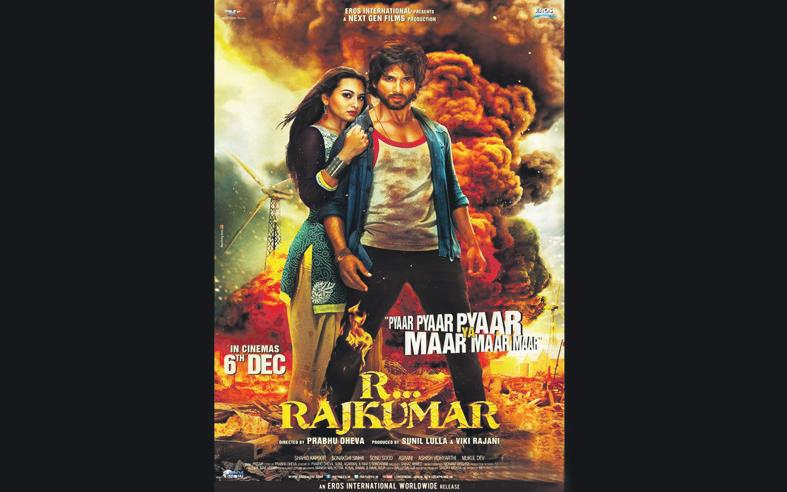


50 DECEMBER (2) 2013 www.indianlink.com.au ENTERTAINMENT
Preparation of the Individual & small to medium sized company Tax return, Partnership, Trust, Superannuation return, Payroll and BAS. registration of ABN and Business Name; Set up of company, Superfund, & Trust. financial Planning, Tax Investment Property, mortgage Loan, Audit for real estate Trust Account, Audit-Solicitor Trust Account, Audit for self-managed superannuation, Travel Agents and all other businesses.
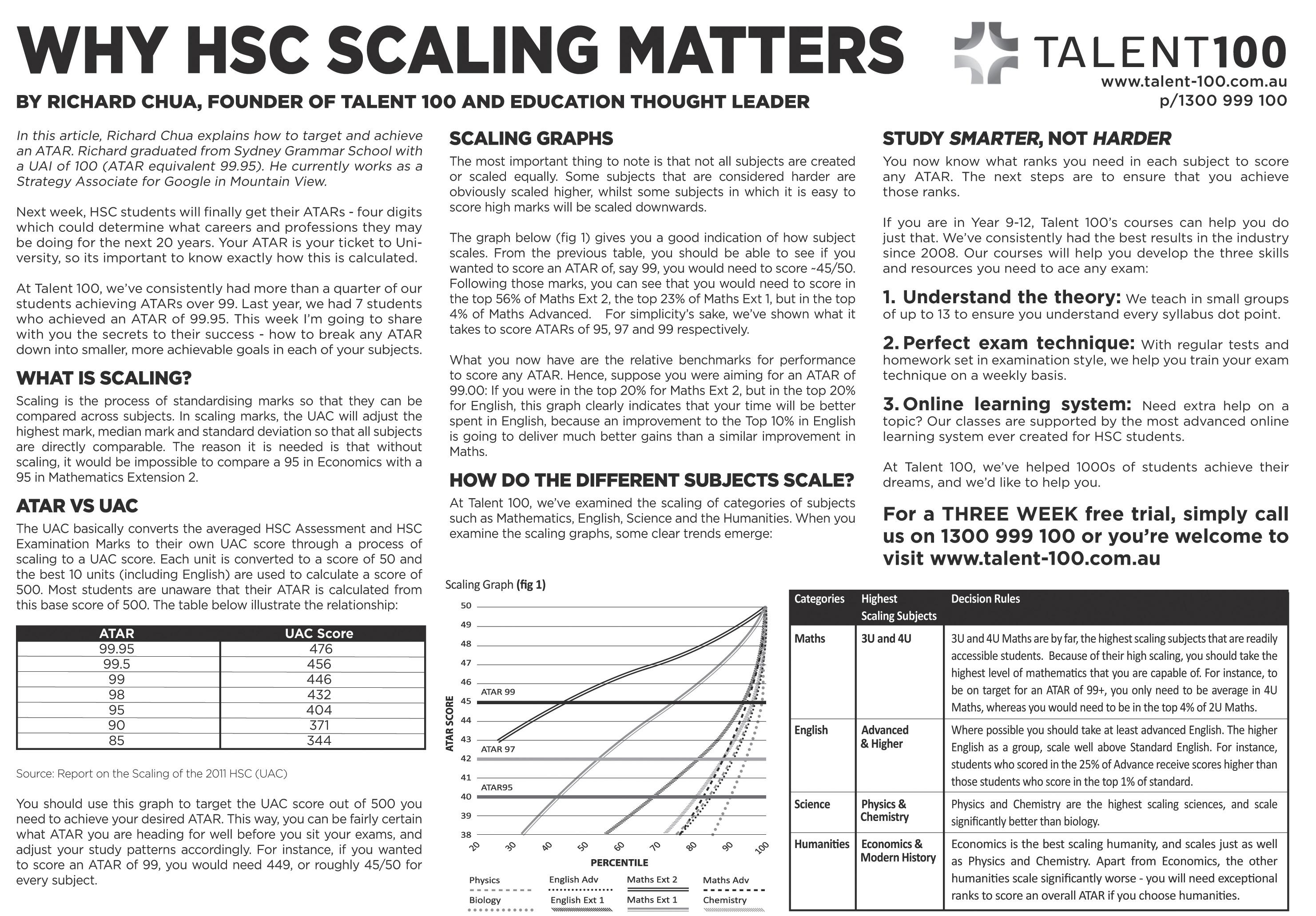



DECEMBER (2) 2013 51 NATIONAL EDITION check out our Website for more Information at www.taxationbusiness.com.au for Best Professional advice & Service, please contact: Waseem Yousef Suite 3, 55 main St. Blacktown NSW 2148 P o Box 8575, Blacktown NSW 2148 Ph: (02) 86787438, (02) 86787437 fax: (02) 86787439 Email: waseemy@taxationbusiness.com.au W IT h 10 Y EA r S of E x PE r IEN c E IN TAxATI o N & Bu SINESS fASTE r rE fu N d WIT h E LE c T ro NI c Lod GE m ENT We are specialized in:
ACCO u NTING TAxATION &
m ENT COR p ORATION pTy LTD Public Accountant & registered tax Agent
I NVEST
ThE BuZZ
END Of ThE ROAD fOR hRIThIK – sussANNE
Bollywood’s in an absolute tizzy over the surprise split between hunk hrithik roshan and his wife Sussanne Khan. The couple announced the split just a few days short of their 13th wedding anniversary. The duo were dating for four years before they tied the knot dec 20, 2000, post the success of hrithik’s debut film Kaho Naa... Pyaar Hai. They have two sons - hrehaan and hridhaan.

Sussanne Khan said their separation is based on their “individual choices”. But, they will continue to care for each other and for their two sons. “We are two individuals who respect and care for each other and have made our own individual choices,” Sussanne said in a statement recently. “We are parents to two wonderful kids and our responsibility remains to protect and take care of them. Nothing can change that,” said Sussanne, who is the daughter of veteran actor Sanjay Khan. Sussanne said she would “appreciate if we are given our privacy in such a time, adding “thank you for your warmth and concern for both of us and the family”.
hrithik has apparently undergone medical treatment for an unspecified condition at an undisclosed location abroad. The Krrish star has been suffering bouts of headaches and in July, he underwent brain surgery for the removal of a clot at a hospital in mumbai.
A day after he officially announced the separation, hrithik took to facebook to share an emotional update. “Sussanne is and always will be the love of my life for the rest of my life. If her smiles are brighter without me, my love for her must accomplish that. unconditional,” posted the 39-year-old, who believes this news must not “disempower my fans and the people about the institution of marriage in any way”.
But fans have been quick to voice their disappointment online using facebook and Twitter, with some hoping that they would reconcile for their childrens’ sake. hrithik fell in love at first sight with Sussanne when he saw her at a traffic light in 1996. So is this the end of the road for the couple? or will they reconcile and walk into their twilight years together? Let’s wait and see...
better in our films”.
Aamir, who reinvented himself with Lagaan, has since stuck to the one film in a year rule and all his releases - Rang De Basanti, Fanaa, Ghajini, 3 Idiots, and critically acclaimed Dhobi Ghat - in the last eight years, except for The Rising: Ballad of Mangal Pandey and Talaash, were not only rich in content, but they, also hit the jackpot at the box office. Its clear that Aamir emphasises on content, while Salman is for potboilers as can be seen by the action drama Dabangg, a film that appealed to both masses and classes. In the last three years, all his releases, including last year’s Dabangg 2 and Ek Tha Tiger, crossed the rs.100-crore mark, even though they were panned by the critics.

“Personally, I feel he is a bigger star than me. he has the ability to take a film on his shoulders. I see that in him. I don’t think I have that. I don’t have any hesitation in saying that, because that’s the truth,” said Aamir, praising his colleague. “I am fond of him. I love him. I like people doing good work,” he added.
The actor also claims that any good film starring anyone makes the actor joyous. “I am not that kind of person. I want to do good work, but it doesn’t make me feel bad if someone else does well. I am also an audience and I love to see good work. Good work gives me joy; so I don’t have that sort of competitive spirit in me and I am happy about that,” he said.
Aamir’s first and last release of the year, Dhoom 3, is under the banner of Yash raj films, and the actor misses legendary filmmaker Yash chopra who died last year, rueing the fact that he is not around to see the release of the film. he, however, equally admires and has “very high regards for Aditya as a producer and director. he is very creative”.
directed by Vijay Krishna Acharya, Dhoom 3 also features Katrina Kaif as well as the duo Abhishek Bachchan-uday chopra who were in the first two parts as well.

As far as his family goes, Aamir
admitted that he would be happy if his daughter Ira joins Bollywood, but says he has no intention of imposing his decision on his children. “I would love that, but I have no idea. I don’t ask them,” Aamir said candidly when asked would he be okay if his daughter joins filmdom. The actor has two children - son Junaid and daughter Ira with his ex-wife reena, and a son named Azad with his current wife and filmmaker Kiran rao. “They should do what they feel like doing. No pressure from me or from any of us. If they decide to come to the films, I would like all my children to enter films,” he said.
“If they enter a field where I am in, Kiran is in, we will be able to work together, hopefully, and that would give me a great amount of joy. So, I would be very happy if my daughter joins the films,” said the 48-year-old actor. It could be a wish come true as Junaid is already assisting director rajkumar hirani in Peekay, which stars his dad.
So would he produce Junaid’s film? “Junaid, why not? If he comes up with a good script and if I have the trust and faith in him as a director, then definitely. he will have to satisfy me like any other director,” stated Aamir.
The actor is also open to doing marathi films, as long as the scripts offered to him are interesting. “I can get along well with marathi. If I get a good script, why not,” he said. “Language has never been a barrier for me. I have learnt marathi, so it will help my marathi (speaking skills), but that’s not why I will do a marathi film. The material has to excite me,” he added.
Well, that’s the round up for 2013 on Aamir Khan, and it seems that the next year is going to be a busy one for the talented actor. We wish him all the best!
going global with Indian cinema
It’s rare to have big guns sitting in on the same forum, but NdTV managed
52 DECEMBER (2) 2013 www.indianlink.com.au
Up-to-date news on what’s hot and happening in Bollywoo ENTERTAINMENT
AAmir Kh
it when celebrating the channel’s 25th anniversary. At the Solutions Summit in New delhi recent, Shahrukh Khan, Amitabh Bachchan and Ar rahman talked about how Indian cinema can reach out to a global audience.
With divides like mainstream and parallel cinema, single screens and multiplexes, Indian cinema lives under a divide which is a deterrent to its own good, King Khan said, even as Amitabh Bachchan felt the need of the hour is to “blend in” to go global.

“until we don’t inculcate a habit of collaborations, we won’t be able to inch towards global cinema,” stated Shah rukh, adding that it is important to be able to give to the world what it
whO wORE
the rs.100 crore mark in 2013, and SrK’s Chennai Express minted a staggering rs.216 crore. mere nomenclature! The forum was made even more interesting when the four panellists got up to do a jig on rahman’s Jai Ho! at the end of the summit. King Khan began the trend by doing a few steps to the tune of the song, and asked Waheeda to join him. The highlight of the impromptu jig was when Shah rukh and Big B danced to some of the latter’s signature steps. certainly a show to make a song and dance about!
CAPTION CONTEsT
What’s vidya Balan saying to her fans here? Send in your responses to win@indianlink.com.au and win a surprise prize



What’s Karan johar saying that’s making Kareena Kapoor so attentive?

Karan: Now here are some of Kareena’s secrets!
Kareena to herself: Omg no Karan NO!

Bhumi Shah Toongabbie, NSW
Bhumi wins a free ticket to new release Dhoom: 3

DECEMBER (2) 2013 53 NATIONAL EDITION
Lea Michele or Bipasha Basu in Versace?
KAtrinA KAif
Ar rehmAn
Share your views with us on our Facebook page /IndianLinkAustralia
LAsT IssuE CAPTION CONTEsT wINNINg ENTRy
AmitAbh bAchchAn
Ask Auntyji
Dear Auntyji
The holiday season is coming closer and I am getting more and more tense. And I’ll tell you why. I am married to an Aussie and he has a large family here, so it is understood that we will celebrate christmas at his parents’ home, as we do every year. But my parents who live in melbourne, have decided to come to Sydney and spend the holidays with us. Naturally, they have been invited to the xmas party, but I am very nervous about it. You see, I come from a very conservative Indian family, and although we have lived in Australia since I was six, my parents have hardly any Aussie friends. They have a large social circle of Indian friends, but my father didn’t even go to his office parties because he does not drink and he is vegetarian. my husband’s family are meat-eaters and beer-guzzlers, and the vegetarian menu for the party is only salads. my mother is very particular about hygiene, so I can’t even imagine how she will react if someone uses their fingers to put a barbequed aloo in her plate. Samaj mein nahin aata, ke kya karon. my parents seem quite keen to meet my in-laws and the extended family, but I feel that they will be shocked and maybe even angry to see what kind of a family I have married into. What to do Auntyji, should I pretend to be sick and make them stay home with me?
Auntyji says
Something tells me that you are behaving more conservative than your parents. Arre nalayak, just because your parents have an Indian social circle, doesn’t mean that they are completely ignorant about Aussie ways. don’t they work in Aussie offices and read Aussie newspapers? And its not like all Indians don’t drink alcohol and eat meat. many do both! Your parents are most likely very well aware of the kind of people who will be at the party, and they are probably quite curious to see this new breed of family into which their beloved beti has married. They don’t need you to make them feel awkward and self-conscious. If they had any reservations, they would have made some excuse not to attend. Thoda soch samajke, you will see the solution. At these gatherings, mostly everyone brings a plate of food. You take two, some delicious aloo bondas (less mirchi) or paneer pakoras, and some tomato or lemon rice which your parents can safely enjoy. That way, they will be able to have their lunch as a part of the spread, without having to surreptitiously carry a dhaba for them. Get your dad to sit with a glass of coke, which everyone there will assume is a bourbon mixer. Problem solved! Aur yaad rakhna, Australia is more multicultural than you imagine, so I’m sure your parents will be treated with respect and they will have a good time. So relax and enjoy yourself too!
Dear Auntyji



my problem has to do with one specific New Year’s resolution. Every single year since I was 20, I have vowed not to smoke a cigarette in the New Year. And every single year, at the New Year party I am attending, I have a few drinks and then have a smoke. What’s going on Auntyji, why can’t I stick to my resolution? I am not a regular smoker but I can’t kick the butt because I feel I have already broken my New Year’s resolution on the very first day of the new year. It’s a hopeless situation, please help me Auntyji! I don’t want to bring in this New Year with a smoke!
Auntyji says hmmm, your problem is a tricky one, because your reasoning seems somewhat convoluted. You refuse to give up smoking because you break your New Year’s resolution not to smoke immediately after making it, and that decision reflects on the whole year. Well, there is not just one easy solution but two, only you have to convince your bhurji bheja that either is the right one for you. first, make a New Year’s resolution to keep smoking, and then automatically your brain will do the opposite, and you won’t smoke during the New Year. You can then maintain that logic for the rest of the year and not smoke. The second solution is to make a resolution to not smoke from the second day of the year. So enjoy that cigarette on January 1, knowing that it will be the last for the rest of the year. Either way, you’re a winner. Samaj mein aaiye baat? or is my reasoning too complicated for you? Also, for each day you smoke, think of the eventual consequences – just look at the packaging for inspiration. Chhod do, gandha aur bekaar habit hai!
54 DECEMBER (2) 2013 www.indianlink.com.au
Parent tension BACKCHAT Email info@indianlink.com.au Do you have a question for Auntyji?
Like us on facebook for a chance to win tickets to Band of Magicians /IndianLinkAustralia
Smoke solution



DECEMBER (2) 2013 55 NATIONAL EDITION
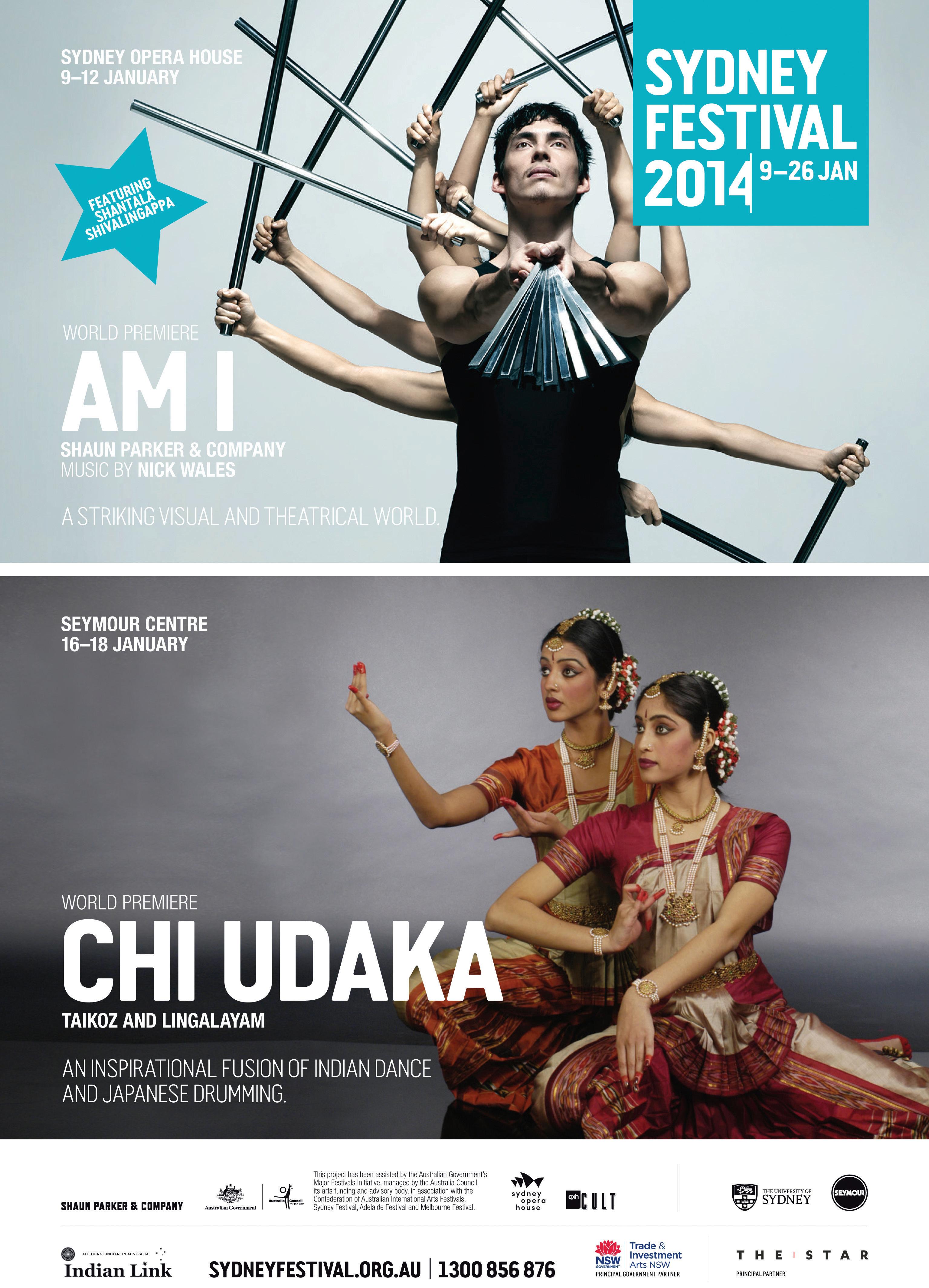
56 DECEMBER (2) 2013 www.indianlink.com.au

DECEMBER (2) 2013 57 NATIONAL EDITION

58 DECEMBER (2) 2013 www.indianlink.com.au

DECEMBER (2) 2013 59 NATIONAL EDITION

60 DECEMBER (2) 2013 www.indianlink.com.au
































































 BY JYOTI SHANKAR
BY JYOTI SHANKAR






 BY MOHAN DHAll
BY MOHAN DHAll













































































































